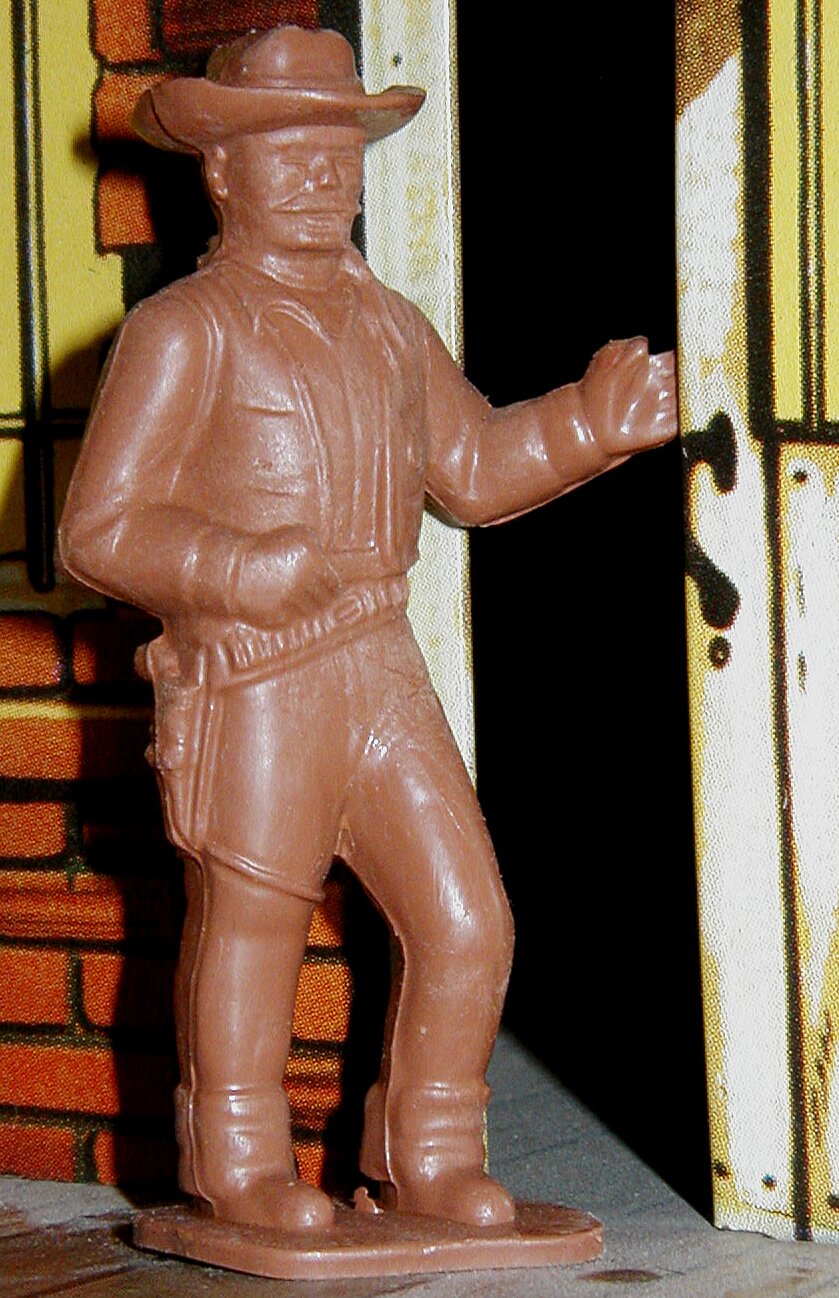 Table of Contents
Table of Contents
Click on section to move to it.
| An Inventory of Marx Playset Figures and Accessories Manufactured from 1951 to 1979 Page 11 - A Virtual Wonderland of Marx Wild West Playsets |
 Table of Contents Table of Contents
Click on section to move to it.
|
||||
| Introduction | Custer's Last Stand |
Large Scale Sets | Rin Tin Tin | Western Ranch |
| The Alamo | Daniel Boone | Lone Ranger | Roy Rogers | Western Towns |
| Alaska | Fort Apache | Small Scale Sets | Wyatt Earp (see Western Towns) | |
| Comanche Pass | Fort Dearborn | The Rifleman | Train Sets | Zorro |
| Canadian Sets |
Gunsmoke | Wagon Train | Sorry but it's not... | |
| Cowboys and Indians | Johnny Ringo | Wells Fargo | Re-issue Boxes | |
| Back to Wild West Table of Contents | ||||
| Back to Main Table of Contents | ||||
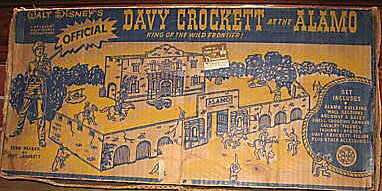 Name: Walt Disney's Davy Crockett at the Alamo Name: Walt Disney's Davy Crockett at the AlamoNumber: 3530 Year first issued: 1955 Photo Courtesy of the late Rob Colwell. |
| Comments This first Alamo play set included 45mm Indians as the Alamo attackers instead of Mexican soldiers. Many collectors believe that this was because Marx did not have the Mexican soldier molds ready by the time that the first playsets had been promised to retailers. That explanation has been challenged by some, but no other reasonable explanation has been provided. The new 54mm Alamo defenders were also not included, and 45mm frontiersmen that had been used in Fort Dearborn took their place. |
| Source(s) PFPC SE and 11, PM 34, Horowitz |
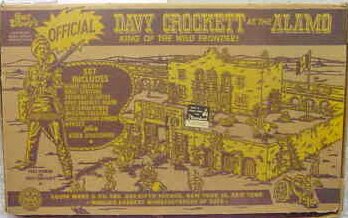 Name: Walt Disney's Davy Crockett at the Alamo Name: Walt Disney's Davy Crockett at the AlamoNumber: 3539 Year first issued: 1955 |
| Comments |
| Source(s) PFPC SE and 11, PM 34, Horowitz |
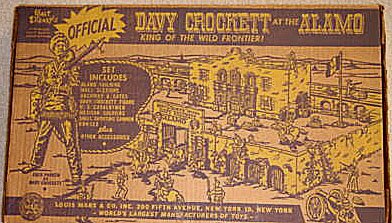 Name: Walt Disney's Davy Crockett at the Alamo Name: Walt Disney's Davy Crockett at the AlamoNumber: 3540 Year first issued: 1955 |
| Comments |
| Source(s) PFPC SE and 11, PM 34, Horowitz |
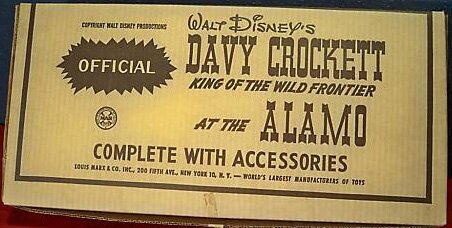 Name: Walt Disney's Davy Crockett at the Alamo Name: Walt Disney's Davy Crockett at the AlamoNumber: 3534 Year first issued: 1955 |
| Comments |
| Source(s) PFPC SE and 11, PM 34, Horowitz |
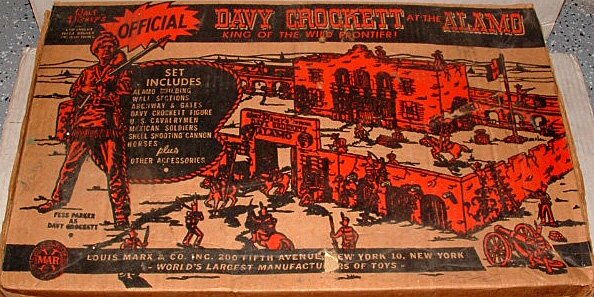 Name: Walt Disney's Davy Crockett at the Alamo Name: Walt Disney's Davy Crockett at the AlamoNumber: 3544 Year first issued: 1955 |
| Comments |
| Source(s) PFPC SE and 11, PM 34 |
| Recent Price Lines I Have Noticed | ||||
| $266 | June 2011 | Seems like a good deal for the buyer | ||
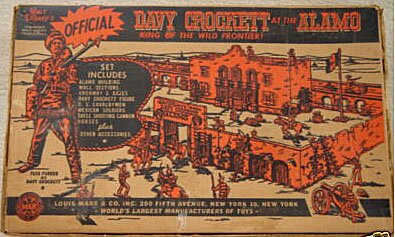 Name: Walt Disney's Davy Crockett at the Alamo Name: Walt Disney's Davy Crockett at the AlamoNumber: 3545 (?) Year first issued: 1960 |
| Comments |
| Source(s) PFPC SE, PM 15 |
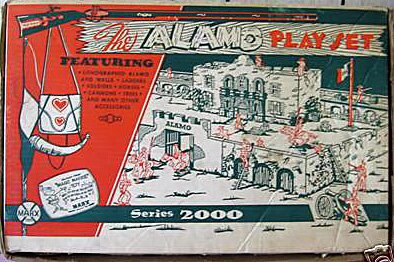 Name: The Alamo Play Set Name: The Alamo Play SetNumber: 3543 Year first issued: 1960 |
| Comments Collectors call this playset the John Wayne Alamo, because it was issued to take advantage of the release of the John Wayne Alamo movie in 1960. |
| Source(s) PFPC SE and 11, PM 15, Horowitz |
| Recent Price Lines I Have Noticed | ||||
| $350 | June 2011 | Asking price by vendor at Marx Convention. | ||
Number: 3546 Year first issued: 1960 |
| Comments |
| Source(s) PFPC SE and 11, PM 15, Horowitz |
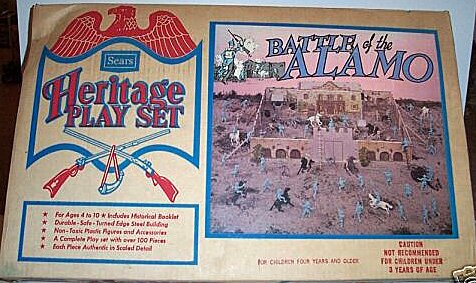 Name: Battle of the Alamo Name: Battle of the AlamoNumber: Marx No. 3548, Sears No. 59091C Year first issued: 1972 |
| Comments In an effort to renew interest in playsets soon after it purchased the Louis Marx Co., Quaker Oats released four "Heritage" sets that were sold only by Sears Roebuck. The Battle of the Alamo was one. This last Alamo playset was the only one to include both types of Mexican soldiers made by Marx, the Shako hats that were included in the original Alamo sets and those that wore sombreros that were made for Zorro playsets. |
| Source(s) PFPC SE, PM 15 and 40, Horowitz |
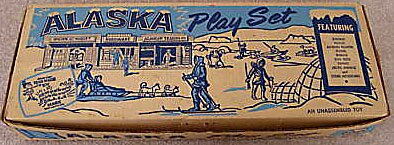 Name: Alaska Play Set Name: Alaska Play SetNumber: 3708 Year first issued: 1959 |
| Comments The Alaska Play Set -- which was named Alaska Frontier Play Set before final production -- included the Marx 54mm trappers and miners sets, along with Eskimo and Arctic explorer figures. It also included what was previously a Wells Fargo town front, but with a revised litho showing the Golden Nugget, a Hardware Store, and the Alaska Trading Company. The set was released the same year that Alaska became the 49th state and according to PFPC Issue 4 "was meant to be a commemorative edition to the Gold Rush era." Toy Soldiers and Collectibles magazine points out that "What makes the Alaska set unique is the combination of both a civilian and military theme (cowboys, if you will). Young boys could enter two worlds at once. A world of Eskimos, polar bears, and igloos, and another world of trappers, miners, frontiersmen, and cowboys with a western town." |
| Source(s) PFPC SE and 4, PM 16, Toy Soldiers and Collectibles magazine Issue 1 |
| Recent Price Lines I Have Noticed | ||||
| $910 | April 2011 | Ebay | ||
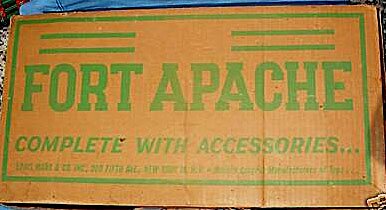 Name: Fort Apache Name: Fort ApacheNumber: 3632-C Year first issued: 1959 (?) |
| Comments Based on the few sets I have seen for sale, this one included unique light blue 60mm Cavalrymen, red brown and yellow 60mm Indians, a firing silver cannon, a crooked-horseshoe cabin, two of the L-shaped stockade walls, and a Canadian flag. |
| Source(s) PFPC 55 |
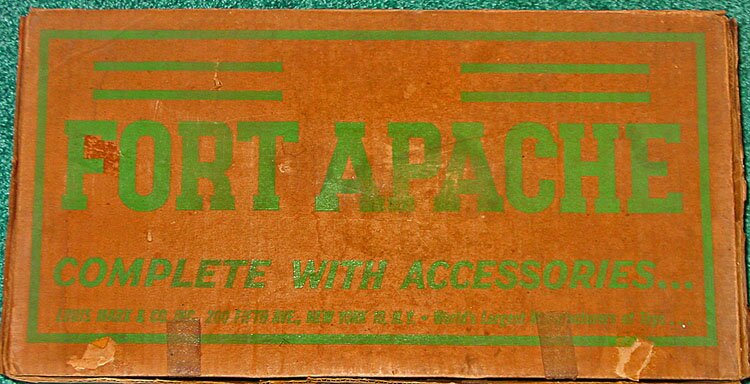 Name: Fort Apache Name: Fort ApacheNumber: 3634-C Year first issued: 1958 Photo courtesy of David Schafer. |
| Comments Bill Schafer discusses this playset in Playset Magazine Issue 14. |
| Source(s) PM 14 |
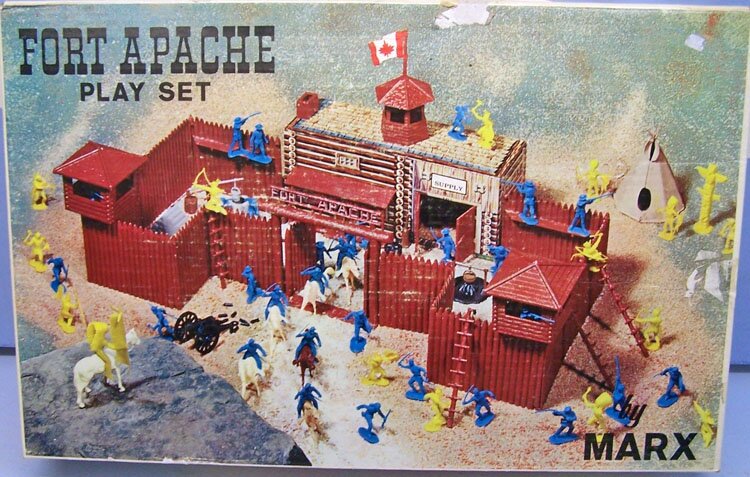 Name: Fort Apache Name: Fort ApacheNumber: 3681-C Year first issued: 1967 (?)  Photos courtesy of Ebay ID marxy1950 |
| Comments |
| Source(s) PM 20 |
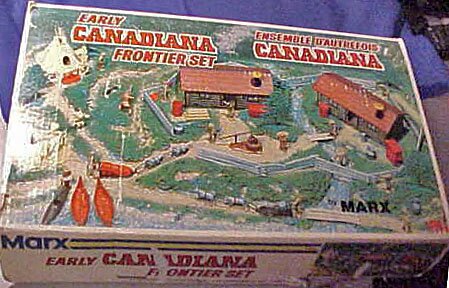 Name: Early Canadiana Frontier Set Name: Early Canadiana Frontier SetNumber: 4610 Year first issued: 1972 |
| Comments Two tin litho cabins plus a couple of canoes!?! And is that a kayak alongside them? Note the Civil War fence and unusual-looking tepee. |
| Source(s) PFPC 5, 29, and 55 |
| Recent Price Lines I have noticed | ||||
| $510 | November 2011 | Ebay | ||
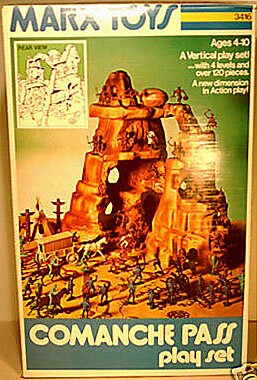 Name: Comanche Pass Play Set Name: Comanche Pass Play SetNumber: 3416 Year first issued: 1974 |
| Comments The most prominent feature of the set, of course, is the "pass" which is made up of five pieces plus a boulder for the Indians to push off on the unsuspecting cavalry below. Marx -- sold by Louis Marx to Quaker Oats two years earlier -- went a little wild in its figure colors in this set, including the only known pea green set of 54mm pioneers and flesh-colored 54mm Indians, but they at least kept the cavalry to a medium blue. The set also included a supply wagon (driven by a lime green wagon driver with whip) and a nice 32-inch by 36-inch vinyl playmat. According to an article by Tim Geppert in PFPC Issue 34, the mountain piece was also included in Marx Guns of Navarone, Iwo Jima, and some Prehistoric playsets. Tim stated that other collectors have told him the mountain was also in a Marx wild west playset called Ambush at Falling Rock (see below), but that he had never seen such a set. Neither have I. The PFPC article states that Comanche Pass was sold in 1972. However, documentation from Marx in Horowitz' book "Marx Western Playsets" shows a date of 1974 and states that it was initially released after Louis Marx sold the company to Quaker Oats. |
| Source(s) PFPC SE and 34, Horowitz |
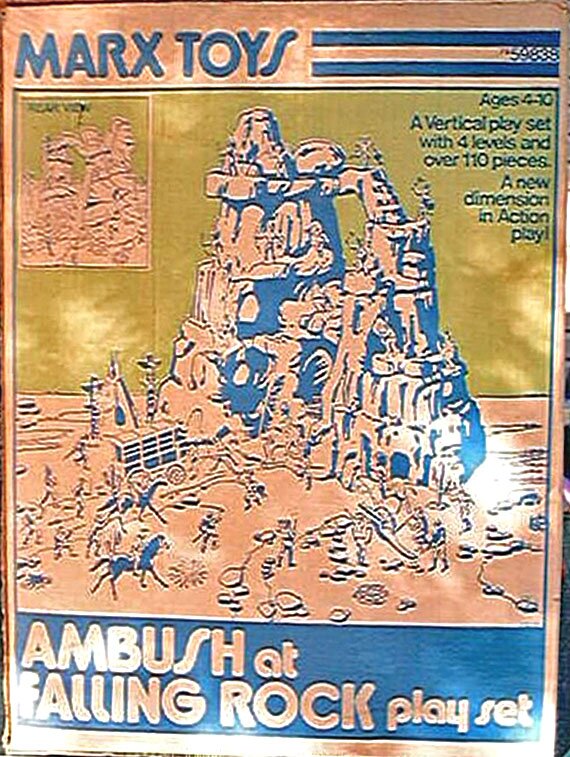 Name: Ambush at Falling Rock Name: Ambush at Falling RockNumber: 3423 Year first issued: 1975 Photo courtesy of Paul Cuomo. |
| Comments This playset is so hard to find that for several years collectors could not decide whether it existed or not. However, Jay Horowitz lists it in his book "Marx Western Playsets, The Authorized Guide," and I have corresponded with several people who own it (note photo of box above). It was in the 1975 Sears Catalog. Horowitz states that it is similar to Comanche Pass, but with fewer pieces. |
| Source(s) PFPC 34, Horowitz, above box photo from Paul Cuomo |
Number: 3949 Year first issued: 1953 |
| Comments Based on an article in Playset Magazine Issue 2, this set is almost identical to version #3950 that follows. The only difference is the type of a few of the terrain pieces such as trees and rocks. Perhaps its box cover was also the same. |
| Source(s) PFPC SE, PM 2, Horowitz |
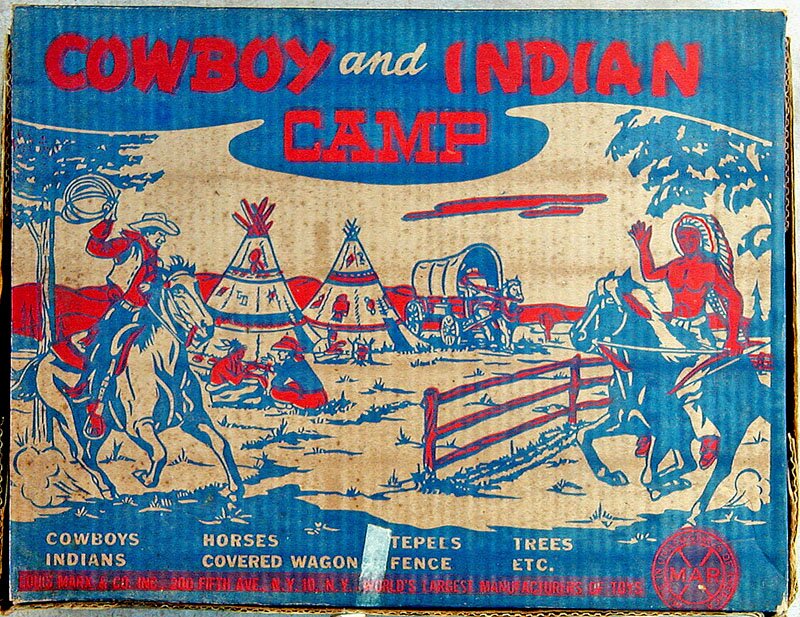 Name: Cowboy and Indian Camp Name: Cowboy and Indian CampNumber: 3950 Year first issued: 1953 |
| Comments This is one of the few playsets that came with Marx' 45mm cowboys. It also had the 45mm Indians from Fort Dearborn, the rarely seen 60mm covered wagon, and three 60mm teepees. The set and the previous set #3949 were not sold by Sears or Wards, but rather could be found at five-and-ten-cent stores such as Kresge. |
| Source(s) PFPC SE, PM 2, Horowitz |
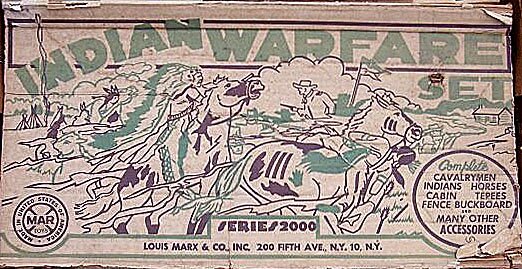 Name: Indian Warfare Set Name: Indian Warfare SetNumber: 4778 Year first issued: 1957 Photo courtesy of Michael Bush, Ebay newstuff |
| Comments The Indian Warfare Set has an interesting combination of pieces at a time that Marx was in the process of converting its playsets from 60mm scale to the smaller 54mm scale. The set has no items that are not in other playsets and is rarely seen today. It was one of the first sets to include Marx' 54mm pioneers (first used in Alamo playsets), 54mm Indians, and 54mm horses (including two red-brown lying-down horses). It also included the downsized log cabin with smokestack, as well as the new 54mm teepee, Indian small accessory sprue, 3-piece Indian accessory set, and 12 pieces of the small brown farm-style board fence. However, despite all the 54mm scale items, it was one of the few sets to have two 60mm covered wagons -- converted blue buckboards -- pulled by 60mm draft horses with seperate harness. According to PFPC Issue 27, one wagon was dark brown and the other blue, both with light tan tops. One horse was red-brown; the other gray. PFPC purports that "The theme (of the set) was intended to represent a small homestead on the prairie with a nearby Indian encampment." Contents are surprisingly similar to Wagon Train playsets produced in 1958 and early 1959. |
| Source(s) PFPC SE and 27, PM 20, Horowitz |
 Name: Cowboy and Indian Set Name: Cowboy and Indian SetNumber: 2660 Year first issued: 1958 Photo courtesy of David Schafer. |
| Comments Described in PFPC Issue 66, the set came in a 22-inch by 15-inch by 8-inch box with the down-sized log cabin already assembled. It also includes a random two hard plastic figures from the Famous Americans group. |
| Source(s) PFPC SE and 66, Horowitz |
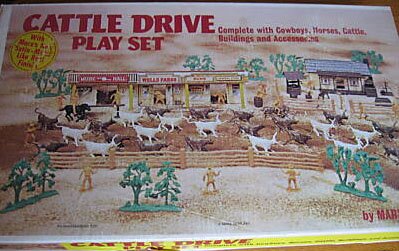 Name: Cattle Drive Play Set Name: Cattle Drive Play SetNumber: 3983 Year first issued: 1972 |
| Comments Cattle Drive included a whopping 25 of the 54mm long horn steers in black, red brown, and beige. It also had two tin litho buildings, the Wells Fargo town front and the Rifleman cabin, both with the new "satin" finish on the exterior, giving them a "dull, more natural appearance," according to PFPC Issue 38. The set is a bit hard to find today. |
| Source(s) PFPC SE and 38, Horowitz |
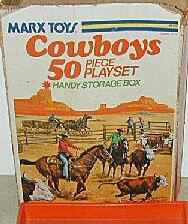 Name: Cowboys 50-Piece Playset Name: Cowboys 50-Piece PlaysetNumber: 2257 Year first issued: 1976 |
| Comments In the late 1970s, the company (already sold by Louis Marx) produced a series of small piece-count playsets called "storage box" sets. Clearly in hope of re-energizing a flagging playset market, these storage boxes were designed to provide a more convenient place to quickly clean up and store playsets with many fewer figures and accessories than came in sets during the hey-days of playsets in the 1950s and 1960s. The sets had generic names, used existing 54mm figure molds, and had no centerpiece, such as a tin litho building or plastic fort. The figures were made in a waxy-looking plastic that are looked down on by many of the "serious" collectors today. I am not sure how popular these sets were back in the 1970s, but they were not able to stop the company from its continuing slide into bankruptcy. Contents of each set were different, but some items were included in all three sets. These included wagons, butterscotch cowboys (from the 54mm cowboy and the 54mm miner and trapper group), 54mm horses, 54mm steers, a wagon driver with whip, and a playmat. Even these, however, were included in varying numbers. For example, the first two playsets seem to have included nine steers, but the third set had only two. However, that final set included Indians, while the first two sets had none, as well as a covered wagon, when the first two just had buckboards. The first Wild West storage box set was the Cowboys 50-Piece Playset. Actually, the Marx Catalog provided to retailers in 1976 (shared with me by veteran collector and seller Mark Hegeman) says the set included more than 50 pieces. However, the catalog photo of the set -- also shown in Jay Horowitz' book Marx Western Playsets -- displays fewer than 50 pieces. The photo shows: 5 54mm cowboys, including two mounted (in butterscotch color) 1 54mm driver with whip (either cream or pea green, hard to tell in the photo) 2 54mm horses (one running, one stopping) 2 54mm harness horses 9 54mm steers 1 54mm buckboard in gray (probably included wagon accessories, but none shown) 4 split log fence pieces 1 stand of trees (to be separated into two pieces) three small accessories (axe in stump, anvil on stump, hitching post) plastic play mat |
| Source(s)s PFPC SE, Horowitz (see color photo 11), Marx 1976 Catalog |
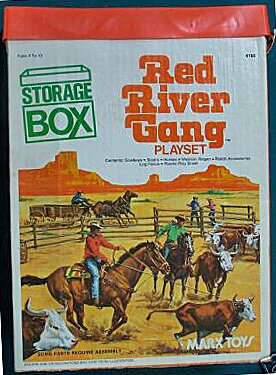 Name: Red River Gang Playset Name: Red River Gang PlaysetNumber: 4104 Year first issued: 1977 |
| Comments The Red River Gang Playset -- using the same box cover as the Cowboys set -- was the company's 1977 Wild West storage box set, very similar to its Cowboys predecessor. The photo in Marx' 1977 Catalog for its retailers shows 40 pieces, though this goes up when counting pieces that went together to make one full piece. For example, the wagon wheels and the hitch would make the wagon six pieces, and the 4-piece well would make four pieces. The photo shows 12 54mm cowboys, 1 wagon driver with whip, 9 steers, 2 horses, 2 harness horses, 5 split log fence sections, a gray buckboard with accessories, six ranch accessories (axe in stump, anvil on stump, forge, axe sharpener, well with bucket, log pile), and playmat. The playmat appears to be similar, but not identical, to the one in the Cowboys Playset. Jay Horowitz includes copies of original Marx bills of material labeled Red River Gang Playset in his book Marx Western Playsets. These show a set that includes 16 54mm cowboys, 14 54mm Indians, a covered wagon with driver and accessories, two horses for riders, an unstated number of steers, a teepee, and a playmat. However, these bills of material are dated February 1978, and the contents are much more similar to catalog photos and a back-of-the-box contents list of the Red River (no Gang) Playset (see below). At the same time, Horowitz' one-paragraph write-up on the Red River Gang Playset refers to a photo of it on another page, but the photo's caption identifies it as the Red River (no Gang) Playset (see below). So my guess (and that is all it is) would be that these bills of material were preliminary for the Red River (no Gang) set, with the name of the set being changed for some unknown reason by that time the set was released in 1978. |
| Source(s) PFPC SE, Horowitz, Marx 1977 Catalog |
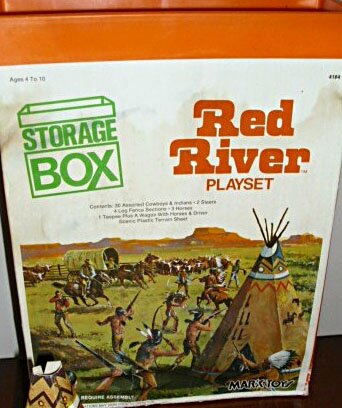 Name: Red River Playset Name: Red River PlaysetNumber: 4104 Year first issued: 1978 (also sold in 1979) 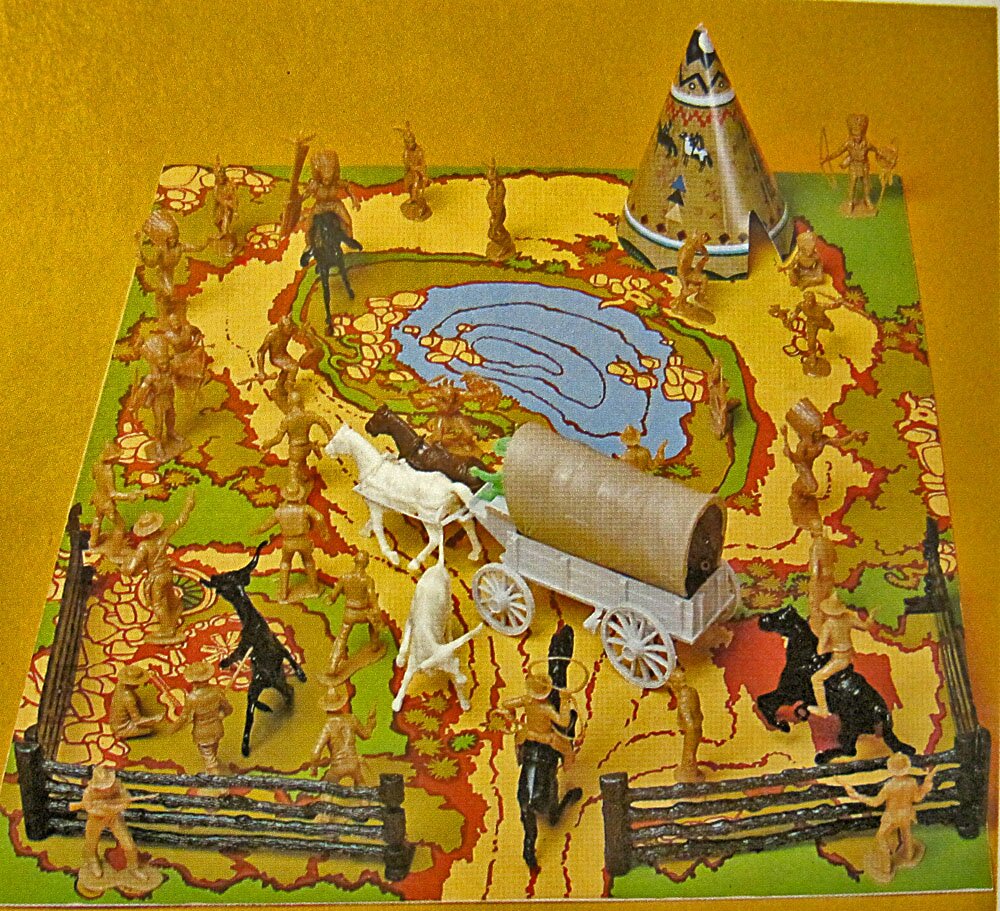 Photo of box front courtesy of Lisa Dwyer. Photo of playset layout courtesy of Mark Hegeman. |
| Comments Antiques seller Lisa Dwyer recently surprised me with the photo above of the Red River Playset box, a playset that I had not realized existed. It is the third and final Wild West storage box set and oddly uses the same playset number as the Red River Gang Playset. Released a year later than the "Gang" set, Indians were more prominent on its box front than cowboys, and Red River is the only of the three Wild West storage box sets to have Indians. Information on this set is all but non-existent in reference books and magazines I have, and little more can be found on the two previous sets, which are clearly related to this one. However, veteran collectors/sellers Mike Handley and Mark Hegeman have assured me that all three exist. Mike reported that he has owned the set and that his included a wagon top in an especially nice caramel color and Indians in orange. Mark has been able to provide detailed information and photos on this set (and the previous two sets) from very-hard-to-find Marx catalogs that the company provided to retailers who sold Marx products (see layout photo above). Mark also has a set, which has a light gray wagon with a beige top, a pea green wagon driver (as seen in the layout photo), and a few other variations from the photo and contents list on the box. Lisa reports that, according to information on the back of the box, the Red River Playset included 30 cowboys and Indians, five horses, two steers, a covered wagon, and three fence sections. This pretty well jives with the February 1978 bills of material in Horowitz' Marx Western Playsets book (see comments on Red River Gang Playset above). The set also had a teepee made out of cardboard (!) and a playmat, which appears to be the same one used in the "Gang" set. I have seen no suggestion that the set had any of the usual ranch accessories, other than the wagon accessories and the Indian totem pole (which was made in the same mold as the Indians). Based on all that, I will venture to provide a relatively accurate contents list as follows: 16 figures from the 54mm cowboy group and 54mm miner and trapper group (in buttscotch color) 1 wagon driver with whip (perhaps in pea green, as the previous two sets) 14 54mm Indians (butterscotch color in the photo of the 1978 version, orange in 1979) 2 54mm horses (stopping and/or running) 1 54mm Indian horse (running) 2 54mm harness horses for wagon 2 54mm steers 1 covered wagon (with wagon accessories) 4 split log fence sections 1 cardboard teepee 1 totem pole 1 playmat (same as the Red River Gang Playset) As far as the name change, perhaps it was simply an attempt to sell more playsets by using a different name, or perhaps Marx ran into problems with another company which claimed the use of the term "Red River Gang." Or perhaps Marx officials felt the term "gang" was no longer applicable when Indians joined the set. Of note, can anyone explain the picutre on this box? The Indians seem to have pitched their teepee near to the cowboys' cattle corral, and the cowboys are now using a covered wagon to attack the Indians. A rather dramatic scene, but it seems a bit odd to me!?! |
| Source(s) PM 11 (page 23, photo of box only), Horowitz (see color photo 10), Marx 1978 and 1979 Catalogs |
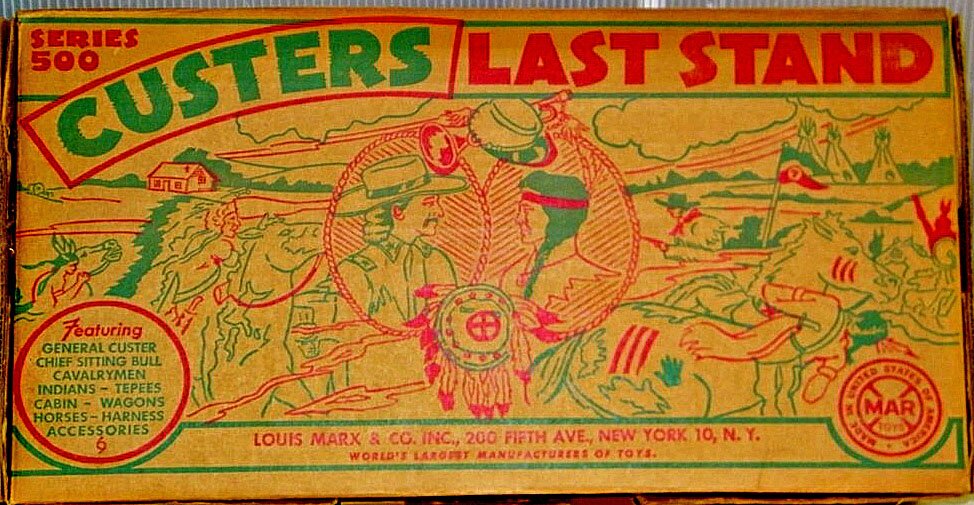 Name: Custer's Last Stand Name: Custer's Last StandNumber: 4779 Year first issued: 1957 Photo courtesy of Steve Trapani. |
| Comments This set came with existing 54mm Alamo frontiersmen and Indians, along with the 60mm poses of Custer and Sitting Bull on small pedastals. |
| Source(s) PFPC SE, PFPC 14, PM 3, and Horowitz |
Number: 4780 Year first issued: 1957 |
| Comments Similar to the previous #4779 set, this one has a few more fence pieces and horses. |
| Source(s) PFPC SE, PM 3, and Horowitz. |
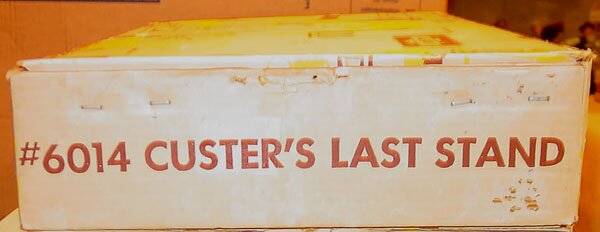 Name: Custer's Last Stand Name: Custer's Last StandNumber: 4670 (Sears No. 6014) Year first issued: 1963 Photo courtesy of David Schafer. |
| Comments This set was apparently the biggest of the Custer sets and was sold by Sears Roebuck, reportedly in a standard Sears All State box. It was one of the last Marx sets to include 45mm figures (10 frontiersmen from Fort Dearborn) and 32 figures previously issued as Civil War soldiers. These included figures which had previously been Confederate troops, but now in Union blue. Collectors today refer to these figures as "Reverse Confederates." Indians included 45 54mm figures, so that when adding in a falling cavalry horse and rider and two wagon drivers, the manpower strength is the same on both sides, much different than in the actual battle. This set also includes four wagons, one with an ambulance top. It did not, however, have a figure identified as Custer. |
| Source(s) PFPC 14 and SE, PM 3, and Horowitz |
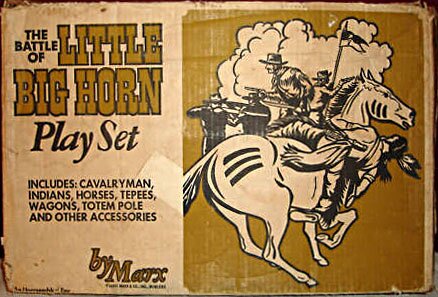 Name: Battle of Little Big Horn Name: Battle of Little Big HornNumber: 4679 Year first issued: 1972 |
| Comments This was the only Marx Custer set with the 54mm Custer character figure and 7th cavalry figures, which were not introduced by Marx until 1968. Otherwise, the contents were similar to #4779 and #4780, lacking such special items as falling horse and rider, pack horses, and reverse Confederates that were included in #6014. However, this one does include four wagons, including a medical wagon. PM says Little Big Horn "...ranks as an elusive and special set." It was sold by J. C. Penney. |
| Source(s) PFPC SE, PM 3, and Horowitz |
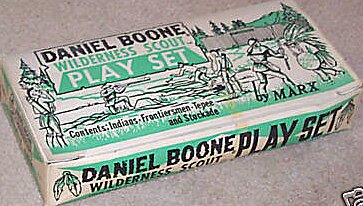 Name: Daniel Boone Wilderness Scout Play Set Name: Daniel Boone Wilderness Scout Play SetNumber: 0631 Year first issued: 1964 |
| Comments The smallest of the three versions, this set included stockade gates and walls that were shorter than the Fort Apache versions and had previously appeared in Marx jungle playsets. The stockade is commonly called the Marx wilderness fort by collectors today. |
| Source(s) PFPC SE and 17, Horowitz |
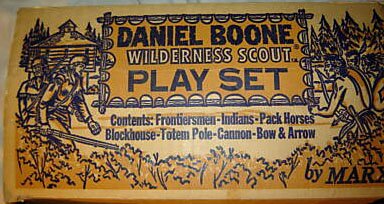 Name: Daniel Boone Wilderness Scout Play Set Name: Daniel Boone Wilderness Scout Play SetNumber: 2640 Year first issued: 1964 |
| Comments The largest of the three versions, this set included the hard plastic, stand-alone blockhouse (which also was in Marx Revolutionary War sets) with the name "Boonesborough" stamped on it in yellow letters. It also included stockade gates and walls that were shorter than the Fort Apache versions and had previously appeared in Marx jungle playsets. The stockade is commonly called the Marx wilderness fort by collectors today. |
| Source(s) PFPC SE and 17, Horowitz |
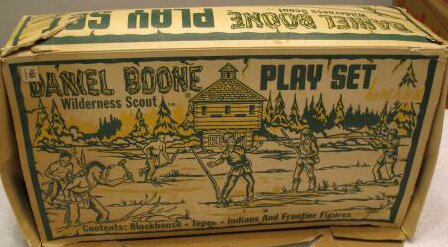 Name: Daniel Boone Wilderness Scout Play Set Name: Daniel Boone Wilderness Scout Play SetNumber: 0670 Year first issued: 1965 |
| Comments This version included the hard plastic, stand-alone blockhouse (which also was in Marx Revolutionary War sets) with the name "Boonesborough" stamped on it in yellow letters. I have alternative documentation that shows the number for this set should be #0760. I have gone with #0670, but welcome correction if appropriate. |
| Source(s) PFPC 17, Horowitz |
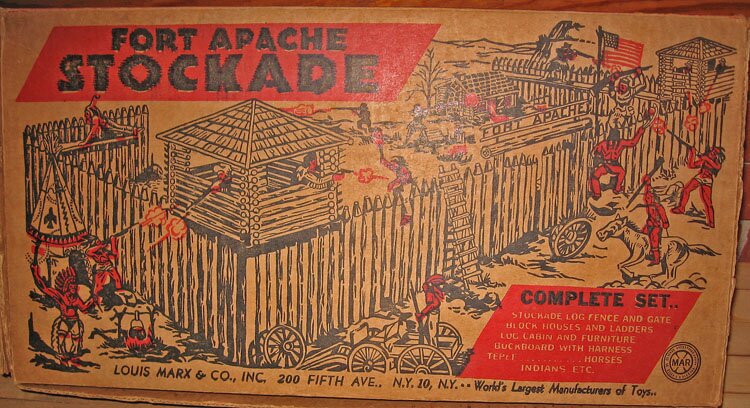 Name: Fort Apache Stockade Name: Fort Apache StockadeNumber: 3609 Year first issued: 1951 Photo courtesy of Rob Colwell, Ebay marxplayer. |
| Comments As seen in the following photos, this same box cover was used for several of the first Fort Apache playsets. This perhaps Marx' first Fort Apache set (#3606 and #3607 are included in factory records, but no such sets are known to collectors today) was the only Fort Apache to use the 45mm figures from the earlier Fort Dearborn playsets. |
| Source(s) PFPC SE, PM 12 |
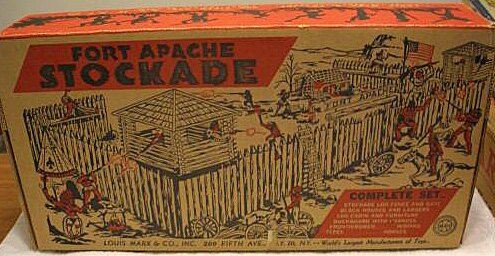 Name: Fort Apache Stockade Name: Fort Apache StockadeNumber: 3612 Year first issued: 1953 |
| Comments This set introduced 60mm pioneers, 60mm stockade and camp Indians, and Marx' shell-shooting cannons. |
| Source(s) PFPC SE, PM 12 |
Number: 3610 Year first issued: 1954 |
| Comments The 60mm skinny Indians first appeared in this playset. Playset Magazine Issue 12 states that this playset number was apparently reserved for Fort Apache earlier, but not used until 1954. |
| Source(s) PFPC SE, PM 12 |
Number: 3614 Year first issued: 1954 |
| Comments |
| Source(s) PFPC SE, PM 12 |
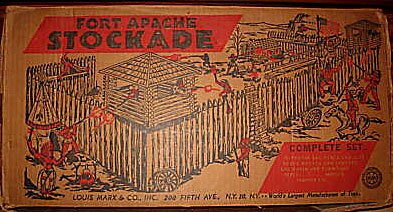 Name: Fort Apache Stockade Name: Fort Apache StockadeNumber: 3615 Year first issued: 1955 |
| Comments This set was a doozy! It came with new 60mm Cavalrymen and the Famous American pedastal group (see Page 2) that had earlier been sold individually in dimestores (Davy Crockett was not included in the set). It also had Stockade and Skinny Indians and the new Marx cavalry saddles for 60mm horses. With the addition of the Famous Americans, the set dropped the buckboard, cabin furniture, trees, and rocks. |
| Source(s) PFPC SE, PM 12 |
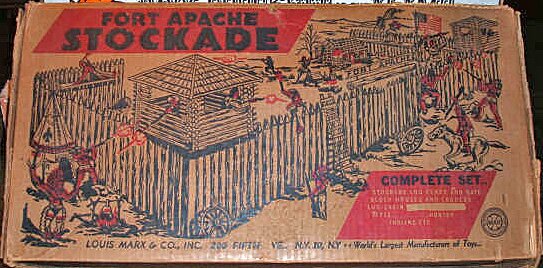 Name: Fort Apache Stockade Name: Fort Apache StockadeNumber: 3616 (with 60mm figures) Year first issued: 1955 Photo courtesy of Bob Szukala. 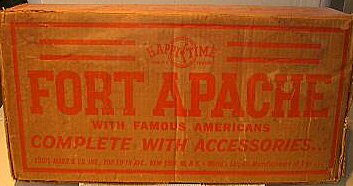 Name: Fort Apache Stockade Name: Fort Apache StockadeNumber: 3616 (with 54mm figures) Year first issued: 1956 or 1957 |
| Comments I have heard conflicting stories about the second box above. According to Rick Eber the top box above was for the first version of Fort Apache 3616, which included 60mm figures. As Marx downscaled its figures from 60mm to 54mm in 1956 and 1957, the second 3616 included 54mm Alamo frontiersmen and 54mm Indians and -- according to Rick -- was also numbered 3616. He also pointed out that the second box was the only set to include the 54mm frontiersmen in metallic blue. Another collector has confirmed that the set included the metallic blue pioneers, as well as tan and silver ones. The Happi-Time designation means that the set was sold by Sears Roebuck. |
| Source(s) PFPC SE, PM 12, Horowitz |
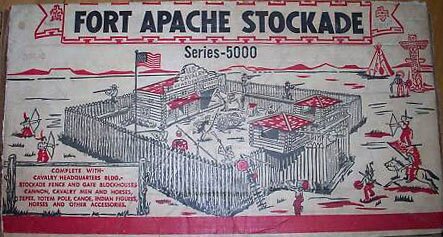 Name: Fort Apache Stockade Name: Fort Apache StockadeNumber: 3675 Year first issued: 1957 Photo courtesy of Jim McGough. |
| Comments |
| Source(s) PFPC SE, PM 14, Horowitz |
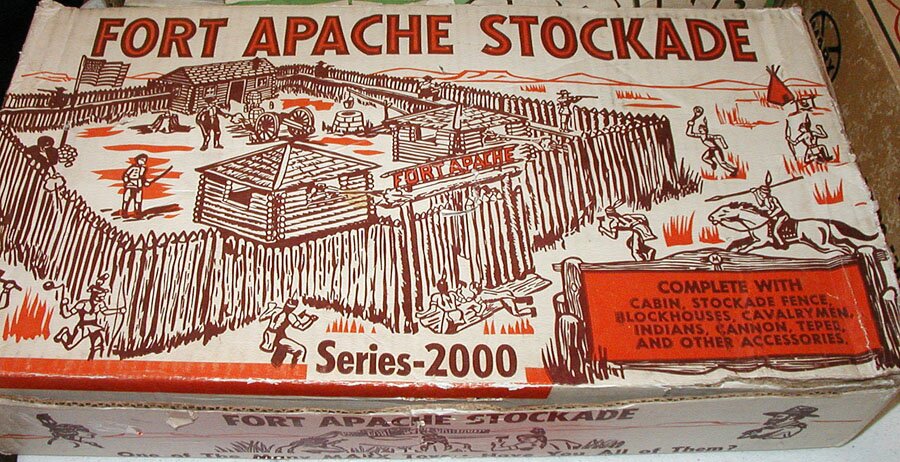 Name: Fort Apache Stockade Name: Fort Apache StockadeNumber: 3660 Year first issued: 1957 |
| Comments |
| Source(s) PFPC SE, PM 14, Horowitz |
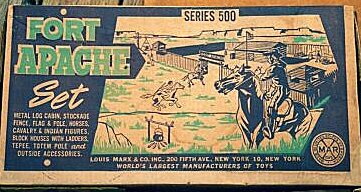 Name: Fort Apache Set Name: Fort Apache SetNumber: 3647 Year first issued: 1957 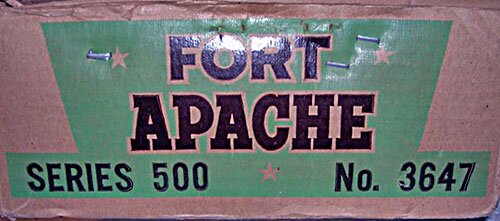 |
| Comments According to Playset Magazine, this set included both 45mm Fort Dearborn pioneers and 54mm Alamo frontiersmen. For some reason, it also did not include a cannon. |
| Source(s) PFPC SE, PM 41 p. 11 |
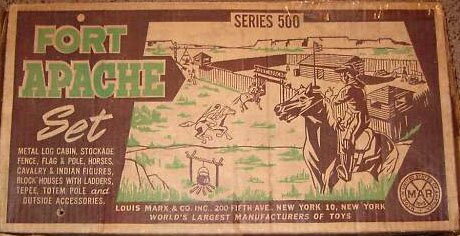 Name: Fort Apache Set Name: Fort Apache SetNumber: 3649 Year first issued: 1958 Photo courtesy of Allan Ford. |
| Comments |
| Source(s) PFPC SE, PM 14 |
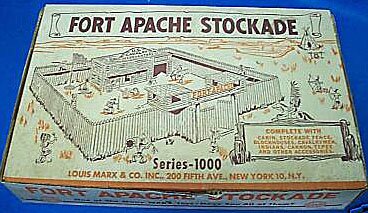 Name: Fort Apache Stockade Name: Fort Apache StockadeNumber: 3678 Year first issued: 1958 |
| Comments |
| Source(s) PFPC SE, PM 14, Horowitz |
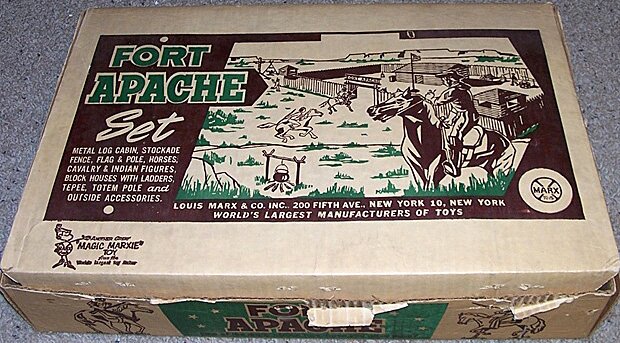 Name: Fort Apache Set Name: Fort Apache SetNumber: 3680 Year first issued: 1959 |
| Comments This set was an inexpensive playset and one of the most popular Fort Apache sets. |
| Source(s) PFPC SE, PM 14 and 16 |
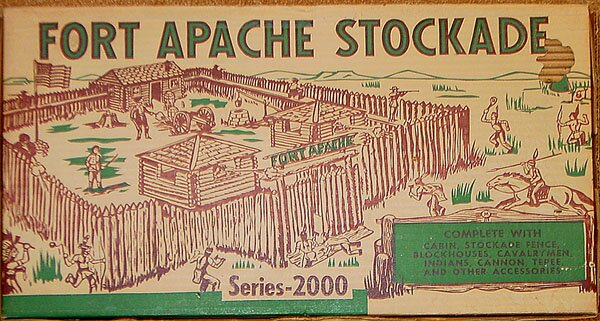 Name: Fort Apache Stockade Name: Fort Apache StockadeNumber: 3682 Year first issued: 1959 Photo courtesy of David Schafer. |
| Comments Despite the picture on the cover of the box, this set introduced the block house over the gate. In this set, the gate had the name Fort Apache heat stamped onto it in yellow. |
| Source(s) PFPC SE, PM 14 |
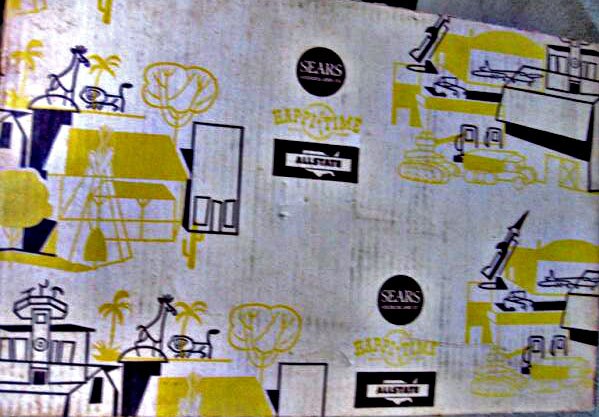 Name: Happi-Time Fort Apache Name: Happi-Time Fort ApacheNumber: 5915 Year first issued: 1961 Photos courtesy of Suzanne Greco 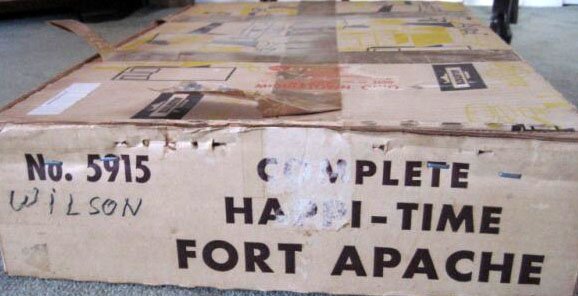 |
| Comments The Happi-Time designation means that the set was sold by Sears Roebuck. |
| Source(s) PM 16 |
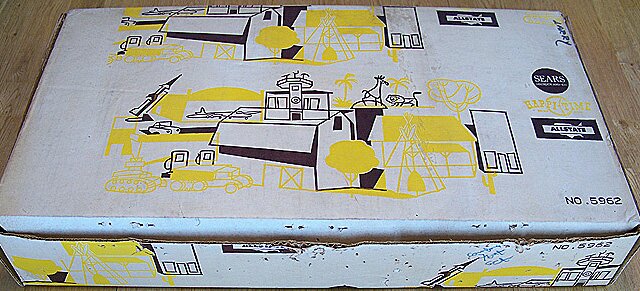 Name: Happi-Time Fort Apache Name: Happi-Time Fort ApacheNumber: 5962 Year first issued: 1962 |
| Comments The Happi-Time designation means that the set was sold by Sears Roebuck. |
| Source(s) PM 16 |
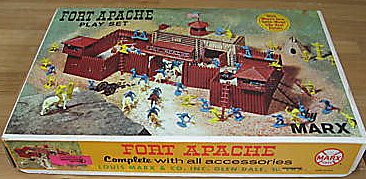 Name: Fort Apache Play Set Name: Fort Apache Play SetNumber: 3681 Year first issued: 1964 |
| Comments This set was a successor to #3680 as a popular, inexpensive set. Canada had its own #3681 with a Canadian flag and instruction sheets in both English and French. |
| Source(s) PFPC SE, PM 16 and 20 |
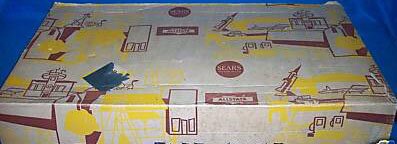 Name: Giant Fort Apache Name: Giant Fort ApacheNumber: 6063 Year first issued: 1964 |
| Comments This large playset was sold by Sears Roebuck. |
| Source(s) PM 16. |
Number: 3684 Year first issued: 1964 |
| Comments This large playset was sold by Montgomery Ward. |
| Source(s) PFPC SE, PM 16. |
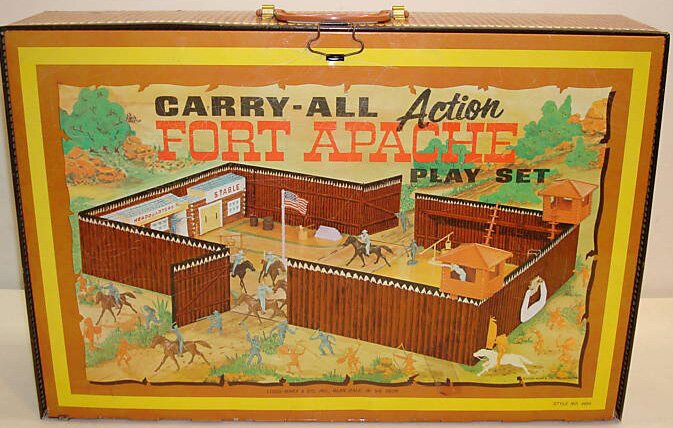 Name: Carry-All Action Fort Apache Play Set Name: Carry-All Action Fort Apache Play SetNumber: 4685 and 4686 Year first issued: 1968 Photo of open case below courtesy of collector Mike Estep. 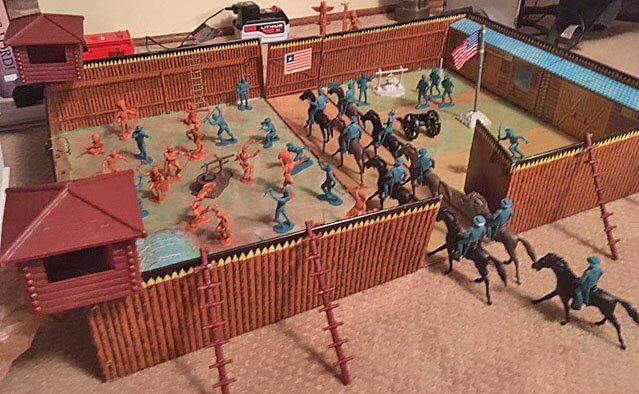 |
| Comments The Carry-All play set was sold in two versions, one with tin litho buildings inside and one with thin painted plastic buildings (as shown on the top of the metal playset box for both versions). |
| Source(s) PFPC SE, PM 20, Horowitz. |
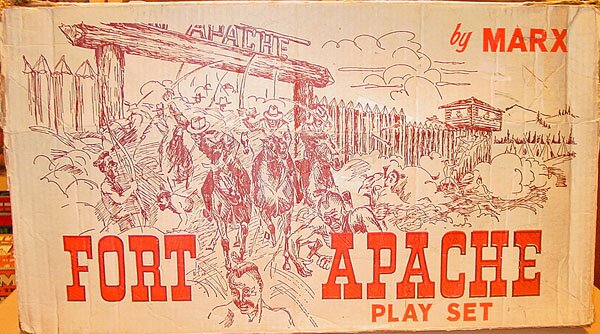 Name: Fort Apache Play Set Name: Fort Apache Play SetNumber: 3686 Year first issued: 1968 Photo courtesy of David Schafer. |
| Comments This playset was sold by Sears Roebuck. |
| Source(s) PM 20. |
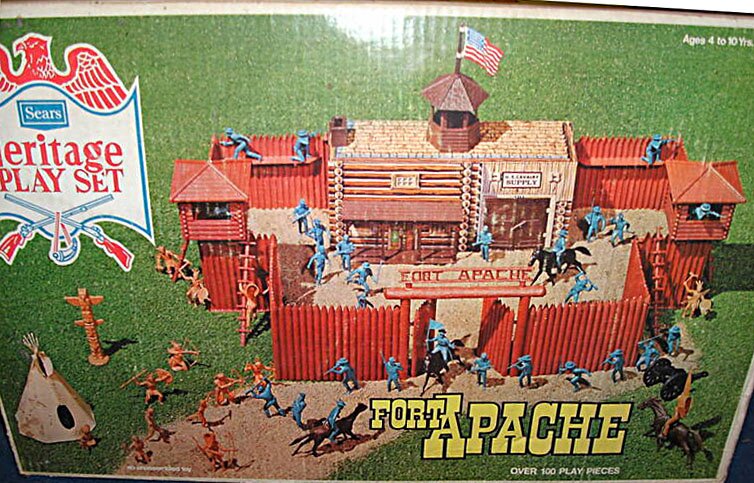 Name: Fort Apache Heritage Play Set Name: Fort Apache Heritage Play SetNumber: 59093-C Year first issued: 1972 |
| Comments In an effort to renew interest in playsets soon after it purchased the Louis Marx Co., Quaker Oats released four "Heritage" sets that were sold only by Sears Roebuck. This Fort Apache set was one. |
| Source(s) PM 20 and 40 |
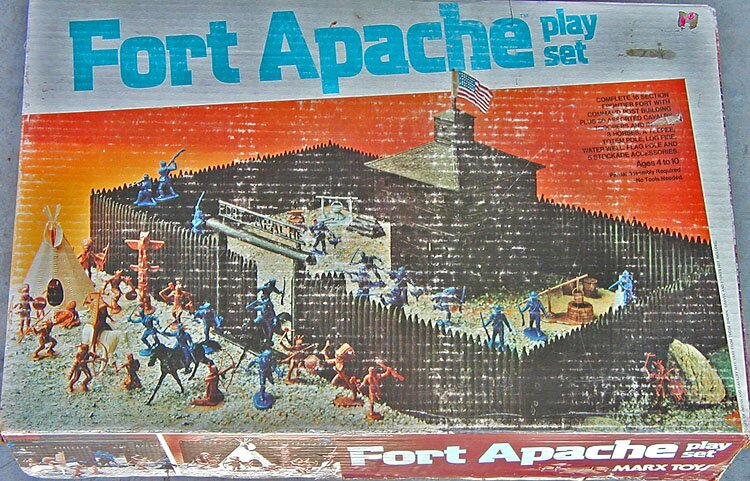 Name: Fort Apache Play Set Name: Fort Apache Play SetNumber: 4202 Year first issued: 1977 |
| Comments This final official version of the Marx Fort Apache play set included uniquely colored sets of both 54mm cavalry and Indians. The cavalry were a deep blue that has come to be known as royal blue by collectors, and the Indians were in a bright orange. They were very colorful, but neither color is popular among collectors today. |
| Source(s) PFPC SE, PM 20, Horowitz |
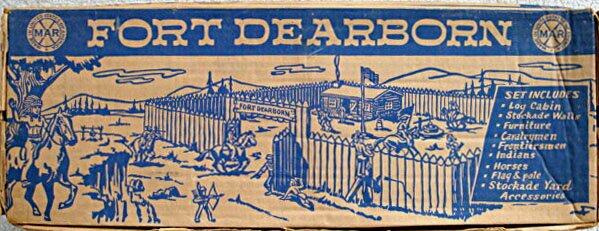 Name: Fort Dearborn Name: Fort DearbornNumber: 3509 Year first issued: 1952 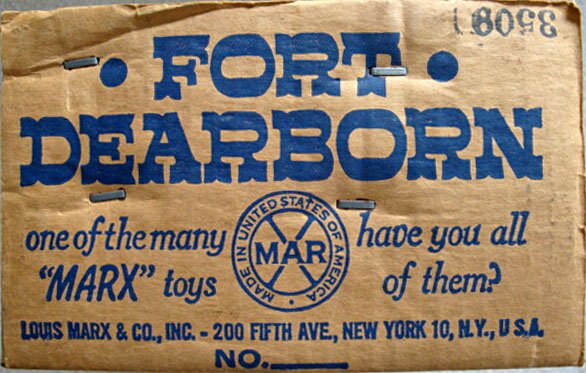 Photos courtesy of Allan Ford |
| Comments |
| Source(s) PFPC SE and 54, PM 21 and 16 |
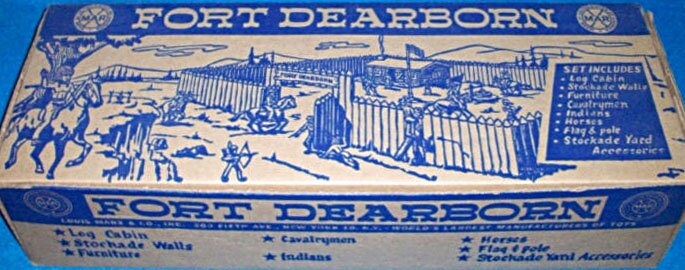 Name: Fort Dearborn Name: Fort DearbornNumber: 3510 Year first issued: 1952 Photo courtesy of Jim McGough. |
| Comments |
| Source(s) PFPC SE and 54, PM 21 |
| Recent Price Lines I Have Noticed | ||||
| $600 | April 2011 | Never played with mint, crisp clean box, from Marx warehouse sale, sold by veteran collector Jim McGough. | This was a good deal for the buyer! | |
Number: 3504 Year first issued: 1953 |
| Comments PFPC 54 states that this playset was never produced, but PM 21 disagrees. |
| Source(s) PFPC SE and 54, PM 21 |
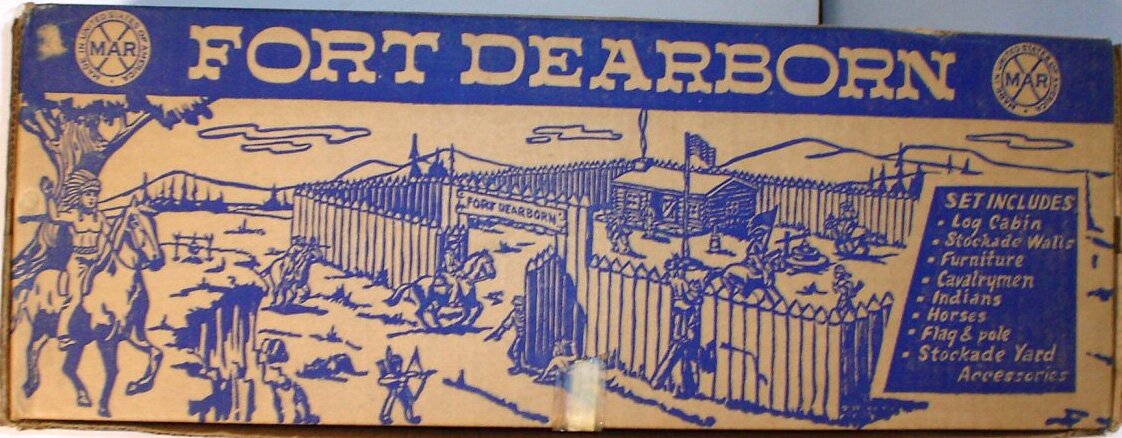 Name: Fort Dearborn Name: Fort DearbornNumber: 3514 Year first issued: 1953 |
| Comments |
| Source(s) PFPC SE and 54, PM 21 |
Number: 2704 Year first issued: 1954 |
| Comments |
| Source(s) PFPC SE and 54, PM 21 |
Number: 2705 Year first issued: 1957 |
| Comments |
| Source(s) PFPC SE, PM 21, Horowitz |
 Name: Fort Dearborn Name: Fort DearbornNumber: 3688 Year first issued: 1972 |
| Comments Produced after Louis Marx & Co. was sold to Quaker Oats, this Fort Dearborn playset was the only version that had Fort Apache-style plastic gate and walls. It included 54mm cavalrymen and Indians and a "satin finish" tin litho Cavalry supply building with plastic cupola and porch. |
| Source(s) PFPC SE and 54, PM 21, Horowitz |
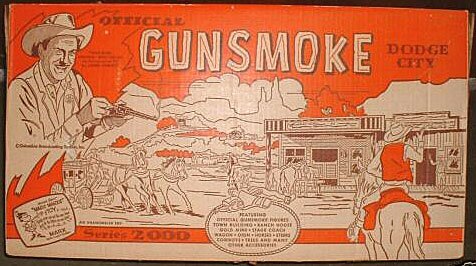 Name: Gunsmoke Dodge City Name: Gunsmoke Dodge CityNumber: 4268 Year first issued: 1960 |
| Comments Besides the four character figures -- Matt Dillon, Kitty, Chester, and Doc -- the set introduced the hard plastic terrain pieces of a mine, sluice stream, and related accessories. The set also includes several other premium items: the Wells Fargo town front, the Rifleman cabin with a unique brown roof and chimney, a red-brown open wagon pulled by oxen, and the rarely seen stagecoach. |
| Source(s) PFPC SE and 8, PM 19 and 16, Horowitz |
| Recent Price Lines I have noticed | ||||
| $5,300 | January 2012 | Ebay | near mint | |
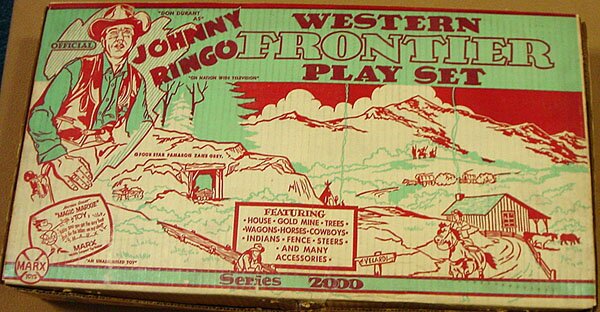 Name: Johnny Ringo Western Frontier Play Set Name: Johnny Ringo Western Frontier Play SetNumber: 4784 Year first issued: 1960 Photo courtesy of David Schafer. |
| Comments The Johnny Ringo playset came out the same year as the Gunsmoke set, but without the town front. It did, however, include several items missing from Gunsmoke. Most importantly to collectors today, it had the Johnny Ringo figure, which now is the most expensive wild west figure that Marx produced. And it had a set of 54mm Indians for the cowpokes to do battle with, which Gunsmoke did not have. The set also included a cabin with a unique cream-colored roof and chimney, three wagons (one in an unusual bright red), and a small sign pointing the way to Velardi, Ringo's town in the television program. |
| Source(s) PFPC SE and 8, PM 19 and 16, Horowitz |
| Recent Price Lines I Have Noticed | ||||
| $452 | June 2011 | Box only - no parts | ||
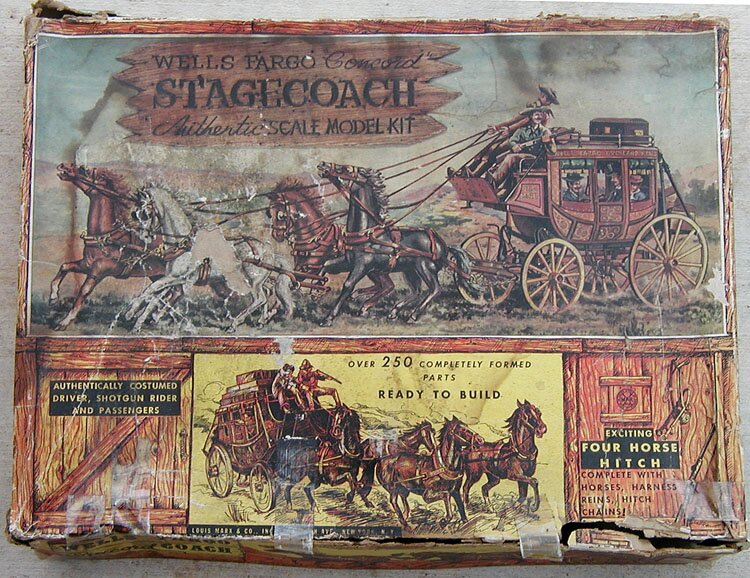 Name: Wells Fargo Concord Stagecoach Model Kit Name: Wells Fargo Concord Stagecoach Model KitNumber: unknown Year first issued: unknown |
| Comments This kit contains 5-inch figures (driver, shot gun rider, holdup man, and four passengers), four horses, whip, and rifle for shot gun rider. Other than the human figures, the kit is in more than 250 pieces that must be assembled by the purchaser. |
| Source(s) I have not seen this documented, but I have the kit. |
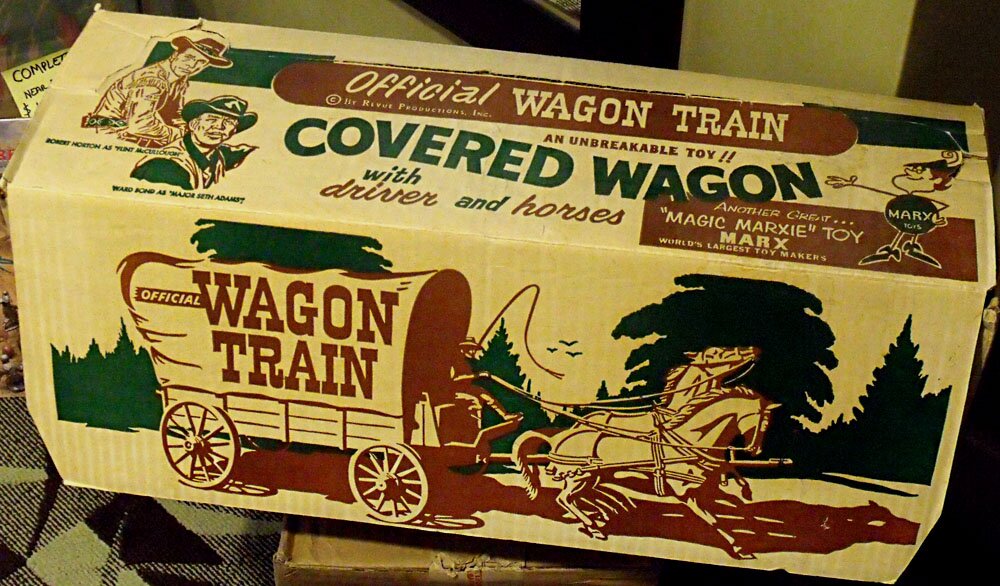 Name: Wagon Train Covered Wagon Name: Wagon Train Covered WagonNumber: 1369-P Year first issued: 1959 Photo courtesy of Rusty Kern of Playset Magazine. |
| Comments Though not really a playset, this box contained the 5-inch driver with two horses and whip. The side of the cloth wagon top reads "Official Wagon Train." You can see the open box on Page 4. |
| Source(s) PFPC 30, PM 43 |
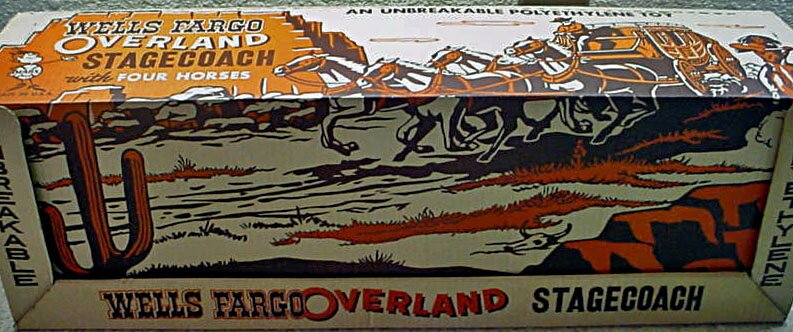 Name: Wells Fargo Overland Stagecoach Name: Wells Fargo Overland StagecoachNumber: 1373 Year first issued: unknown - perhaps 1959 with the Wagon Train covered wagon above Photo courtesy of Rob, Ebay ID cuberforlife. |
| Comments Similar to the Wagon Train covered wagon above, I have not seen this set mentioned in any reference material, but found it up for auction on Ebay. Rob, whom I got the photo from, stated that the number on the box was 1373. It appears to be a companion to the covered wagon, but has a team of four horses instead of two. I'd assume that it included a driver and whip. You can see the open box on Page 4. |
| Source(s) As noted in comments. |
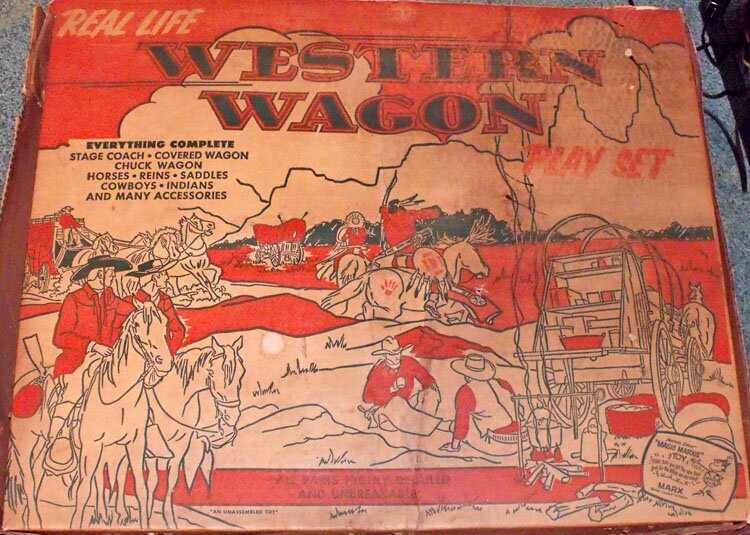 Name: Mammoth Western Wagon Train Name: Mammoth Western Wagon TrainNumber: 4997 or 4998 Year first issued: 1960 or 1965 Photo courtesy of David Schafer |
| Comments This set came in a huge box, about twice as big as a usual playset box. It contains a 6-inch scale covered wagon, chuck wagon, stage coach, and eight horses, as well as covered wagon and chuck wagon accessories. Figures were 5-inch scale, including three wagon drivers, one or two mounted Roy Rogers with pistol in right hand, and two mounted Indians with tomahawk in right hand. Having seen the one owned by David Schafer, I can confirm that it's a beauty! |
| Source(s) PFPC SE and 30, Horowitz |
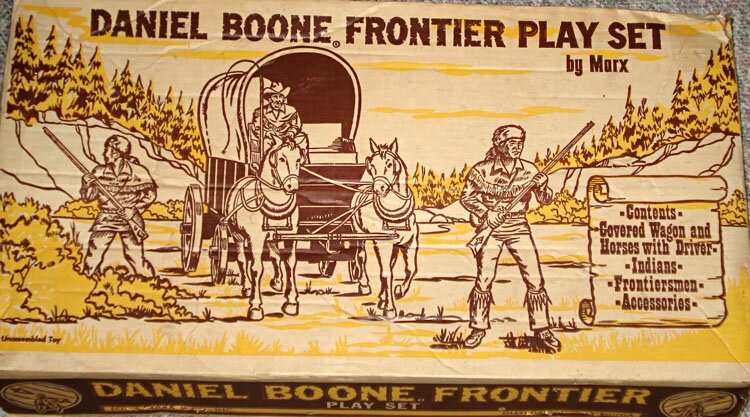 Name: Daniel Boone Frontier Set Name: Daniel Boone Frontier SetNumber: 1393 Year first issued: 1965 Photo at right courtesy of Tom Rash. 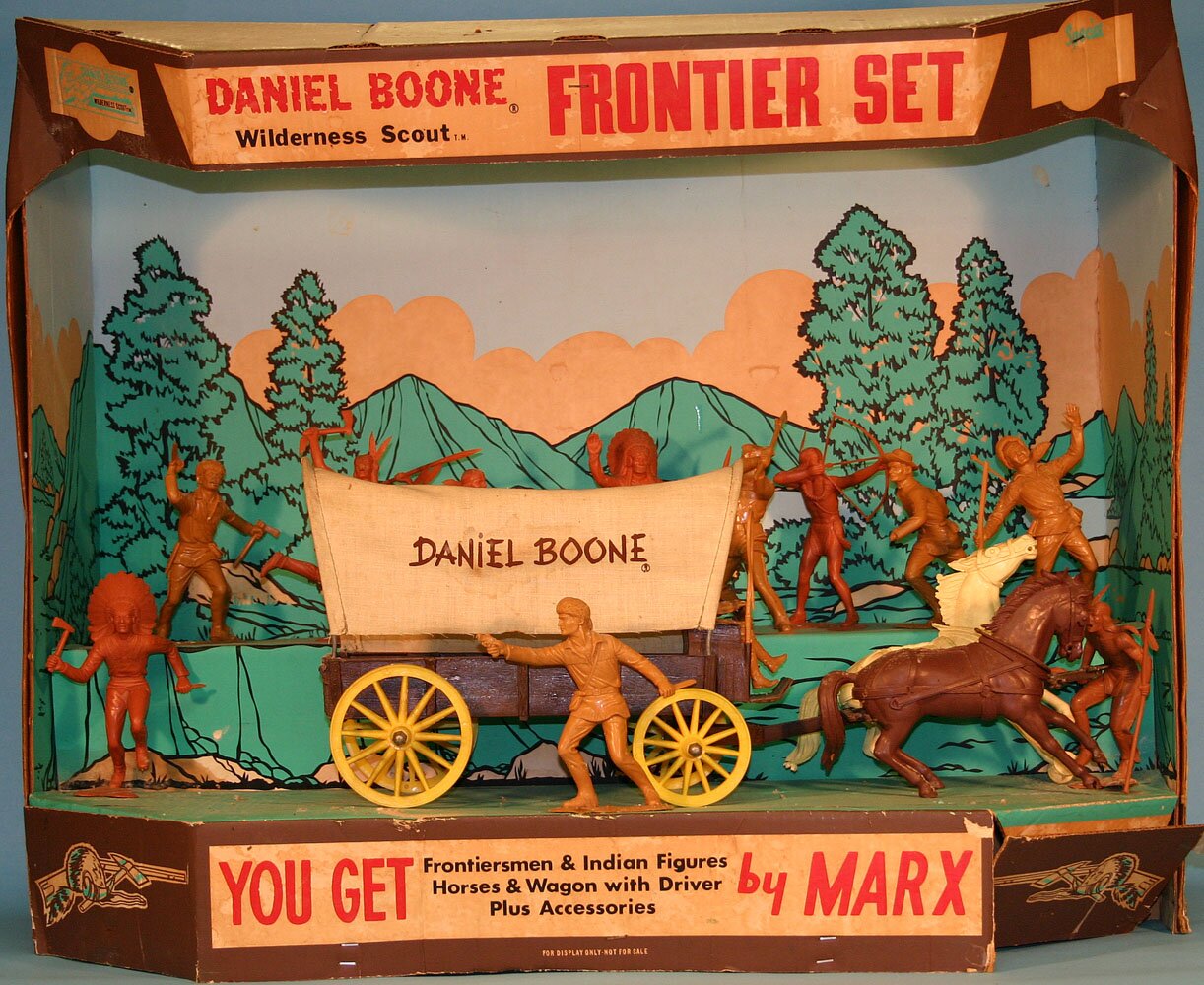 |
| Comments The top photo is of the box (in exceptional condition) for the Daniel Boone Frontier Set, which is a very difficult box to find. The other photo appears to be a store display, though I suppose it could be a variation of the box. I cannot recall where I picked up the "store display" photo (let me know if it is yours), but if it was on Ebay, I am sorry I did not bid and win it. Mark Hegeman has this set, but this photo is not of that one. What a cool set! |
| Source(s) PFPC SE, 17, and 18, Horowitz |
Number: 1394 (?) Year first issued: 1965 |
| Comments This may be the set pictured in PM 43. If so, it contains all three wagons, similar to #4997 and #4998. However, the photo in PM includes two mounted cowboys and two mounted Indians that I am not familiar with. |
| Source(s) PFPC SE, PM 43 (?) |
Number: 1395 Year first issued: 1965 |
| Comments This set contains a large scale stagecoach with three each of 6-inch cowboys and Indians, the 5-inch driver, four horses, and a whip. Horowitz' book "Marx Western Playsets" includes a photo of this set in the box. |
| Source(s) PFPC SE and 5, Horowitz |
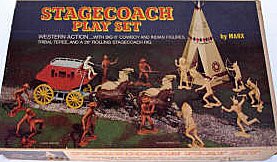 Name: Stagecoach Playset Name: Stagecoach PlaysetNumber: 3814 Year first issued: 1972 |
| Comments This set contains a large scale stagecoach with six each of the 6-inch cowboys and Indians, the 5-inch driver, four horses, a large scale teepee made of paper, and a whip. |
| Source(s) PFPC SE and 5, Horowitz |
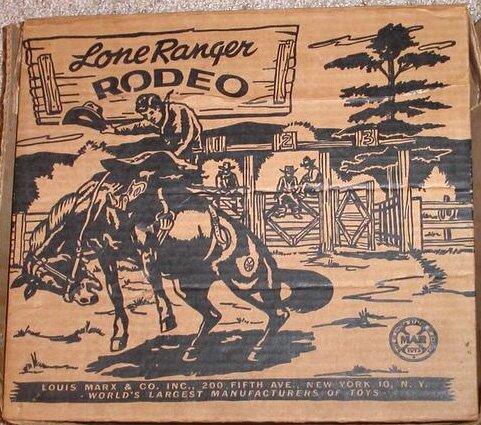 Name: Lone Ranger Rodeo Name: Lone Ranger RodeoNumber: 3696 Year first issued: 1952 |
| Comments Like the Roy Rogers Rodeo set of 1952, this set included a 3-gate rodeo chute instead of a tin litho building. It also included the 60mm ranch cowboys that made their debut that year, as well as the two 60mm poses of the Lone Ranger and Tonto. It was the only Lone Ranger set that 1) had the figures in white (not cream) and 2) included the standing pose of the Lone Ranger. The set also had a white Lone Ranger gateway (similar to the Roy Rogers gateway), the 60mm blue buckboard with vinyl harness, and a 48-star flag. Being a rodeo set, it had no Indians. |
| Source(s) PFPC SE and 50, PM 16 and 55, Horowitz |
Number: 3967 Year first issued: 1957 |
| Comments |
| Source(s) PFPC SE |
Number: 3968 Year first issued: 1956 |
| Comments Playset Magazine reports that this was a small 45-piece set which was a mail order item in the 1956 Wards Christmas Catalog. It includes the Bar M Ranch cabin, split log fence pieces, but a brown Lone Ranger gateway that is unable to attach to the fence pieces. Also, the 60mm cowboys are in soft plastic rather than vinyl. No Indians other than Tonto. |
| Source(s) PFPC SE, PM 55 |
Number: 3969 (brown box) Year first issued: 1957 |
| Comments This set is a mixed scale with the 60mm character figures (no standing Lone Ranger), the new 54mm cowboys, and 45mm Indians (including the scalping Indian that was not a part of the original group). Playset Magazine reports the Indians are in gray and cherry red, while the cowboys have been found in gray, red, and cream. Like #3968 above, the set had the Bar M Ranch cabin and the brown Lone Ranger gate with split log fence pieces. |
| Source(s) PFPC SE and 50, PM 55, Horowitz |
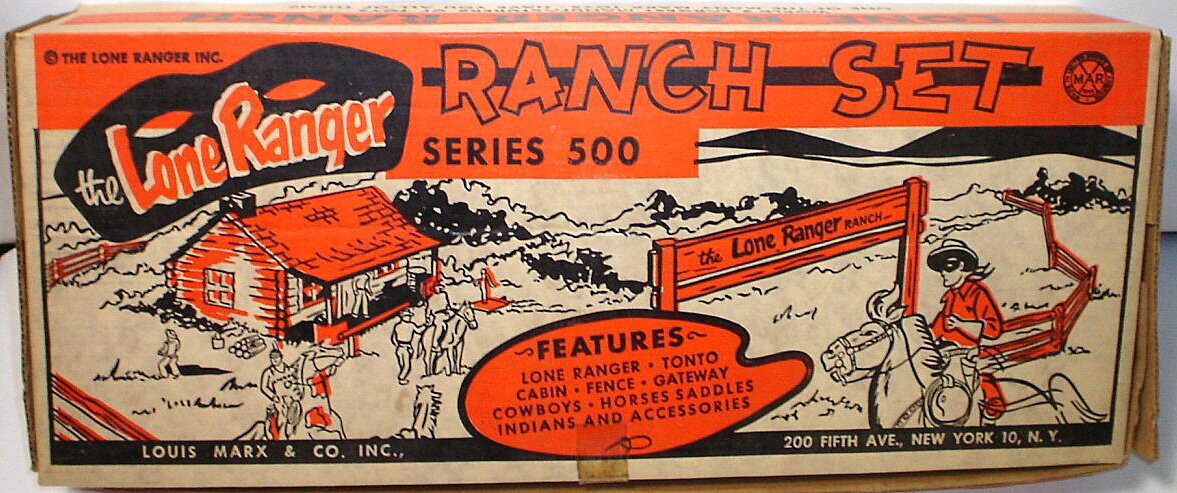 Name: Lone Ranger Ranch Set Name: Lone Ranger Ranch SetNumber: 3969 (white box) Year first issued: 1958 |
| Comments As explained in Issue 55 of Playset Magazine, the contents of this set had several differences from the previous year's set under the same number. The set added the 35-piece cowboy weapons sprue (in flat yellow), but had fewer Indians (in yellow). Its cowboys were gray and tan. |
| Source(s) PFPC SE and 50, PM 55, Horowitz |
| Recent Price Lines I Have Noticed | ||||
| $820 | July 2011 | Never assembled. | ||
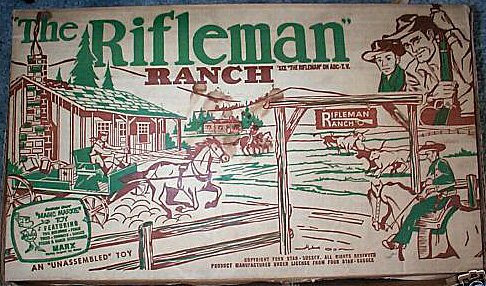 Name: The Rifleman Ranch Name: The Rifleman RanchNumber: 3997-3998 Year first issued: 1959  |
| Comments The Rifleman Ranch set included character figures of Lucas McCain and son Mark, along with a small rifle similar to the Rifleman's rifle, all made in the same mold. The rifle is nice, but in a larger scale than the 54mm figures. Otherwise, the set used items from other Marx playsets: a "Rifleman" version of the gate used in generic Western Ranch playsets, a 60mm blue buckboard, two tin litho cabins (including one Rifleman cabin with a unique light gray porch and chimney), and 54mm cowboys, animals, and accessories. |
| Source(s) PFPC SE and 38, PM 16, Horowitz |
| Recent Price Lines I have noticed | ||||
| $1,575 | December 2011 | Ebay | described as dead mint | |
| $425 | September 2012 | Ebay | great deal for buyer | |
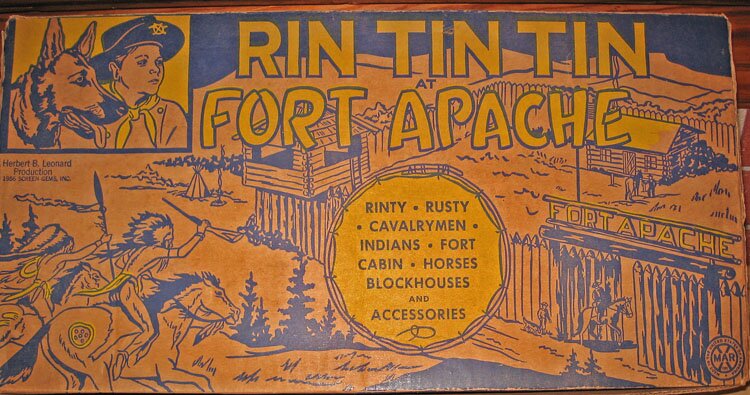 Name: Rin Tin Tin at Fort Apache Name: Rin Tin Tin at Fort ApacheNumber: 3627 Year first issued: 1956 Photo courtesy of Rob Colwell, Ebay marxplayer. |
| Comments One of the two initial Rin Tin Tin at Fort Apache playsets, this set included the three Rin Tin Tin character figures in cream (as did all the Rin Tin Tin playsets), the 60mm Cavalry figures in metallic blue, and a set of each the 60mm Stockade and Skinny Indians -- all in soft plastic. It also has the new down-sized cabin with straight horseshoe door, stovepipe chimney, no floor, and held together in the back by a thick steel wire (often called a back bar or back brace). With no floor, the set does not include furniture found in earlier Fort Apache sets. The stockade has the basic Fort Apache gate and 6-piece blockhouses. |
| Source(s) PFPC SE and 60; PM 12, 15; and 72; Horowitz |
| Recent Price Lines I Have Noticed | ||||
| $450 | June 2011 | Asking price by vendor at Marx Convention. | ||
| $450 | January 2012 | Ebay | ||
Number: 3628 Year first issued: 1956 |
| Comments This set's contents were identical to #3627, but included an extra set of the six Stockade Indians. |
| Source(s) PFPC SE and 60, PM 12 and 72, Horowitz |
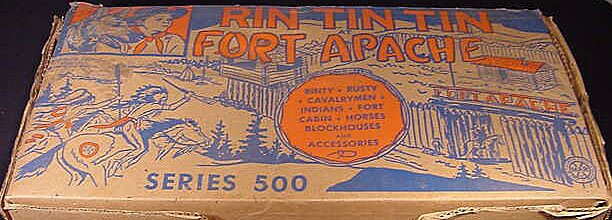 Name: Rin Tin Tin at Fort Apache Name: Rin Tin Tin at Fort ApacheNumber: 3657 Year first issued: 1957 |
| Comments This set is virtually identical to #3658 (see below) except it does not include the new U. S. Cavalry Headquarters building. Instead, it has the down-sized cabin included it the #3627 and #2628 sets (see above). |
| Source(s) PFPC SE and 60, Playset Magazine 72, Horowitz |
| Recent Price Lines I Have Noticed | ||||
| $275 | June 2011 | Asking price by vendor at Marx Convention. | ||
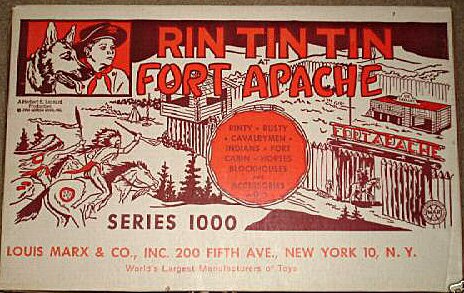 Name: Rin Tin Tin at Fort Apache Name: Rin Tin Tin at Fort ApacheNumber: 3658 Year first issued: 1957 |
| Comments This set usually had two sets of the new 54mm Alamo frontiersmen and two sets of fifteen 54mm Indians. However, a few sets have been found with 45mm Cavalrymen replacing one of the 54mm frontiermen sets. More importantly, the set introduced the new U.S. Cavalry Headquarters, as pictured on the revised box top. This is the building version with plastic pegs representing log ends, similar to Marx' Alamo chapel. In addition, the set introduced the stockade's 2-piece blockhouses, single pole ladders, and L-shaped walls. |
| Source(s) PFPC SE and 60; PM 16 and 72 |
| Recent Price Lines I have noticed | ||||
| $950 | February 2012 | Ebay | near mint | |
Number: 3685 Year first issued: 1958 |
| Comments The PFPC article noted below states the authors had no playset of this number to determine its contents, and Playset Magazine articles do not mention this playset version. Oddly, Horowitz claims that this set replaced the non-Rin Tin Tin Fort Apache #3675 of 1957 and also lists a second version using this number sold through Sears in 1966. I would suspect that any Rin Tin Tin set assigned this number never reached production. |
| Source(s) PFPC SE and 60, Horowitz |
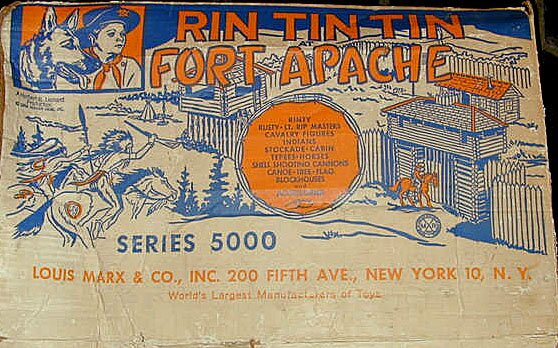 Name: Rin Tin Tin at Fort Apache Name: Rin Tin Tin at Fort ApacheNumber: 3686-R Year first issued: 1958 |
| Comments This final Rin Tin Tin set adds the blockhouse-over-the-gate (which had just been introduced in another Fort Apache set), a firing cannon and shells in a rare silver, and is one of the few wild west sets to include a canoe, in hard plastic red. Some Marx documentation suggests that the set was initially to have a U. S. Cavalry Headquarters building, but it ended up with the down-sized, open door cabin with no floor. In any case, this version has two sets of each 54mm Alamo frontiersmen and 54mm Indians, as well as both Cavalry and Indian small accessory sprues. This was the end of Marx' Rin Tin Tin production. PFPC SE and Horowitz cite #3686 without the -R. |
| Source(s) PFPC SE and 60, PM 14 and 72, Horowitz |
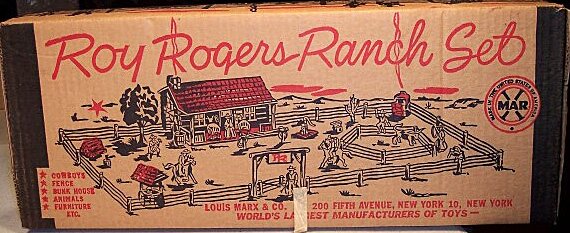 Name: Roy Rogers Ranch Set Name: Roy Rogers Ranch SetNumber: 3979-3980 Year first issued: 1952 |
| Comments Both playset numbers were printed on the box. Factory workers marked out the number that was not valid for the playset. |
| Source(s) PFPC SE, PM 24 |
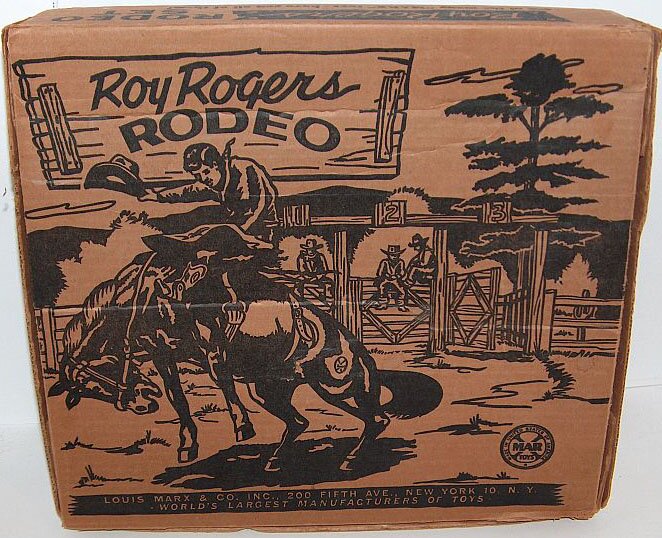 Name: Roy Rogers Rodeo Name: Roy Rogers RodeoNumber: 3690 Year first issued: 1952 |
| Comments Marx' rodeo chutes first appeared in this set. |
| Source(s) PFPC SE, PM 24 |
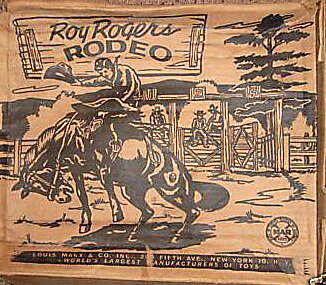 Name: Roy Rogers Rodeo Name: Roy Rogers RodeoNumber: 3689 Year first issued: 1952 |
| Comments |
| Source(s) PFPC SE |
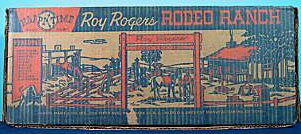 Name: Happi-Time Roy Rogers Rodeo Ranch Name: Happi-Time Roy Rogers Rodeo RanchNumber: 3990 Year first issued: 1953 |
| Comments The Happi-Time designation means that the set was sold by Sears Roebuck. According to PM, this set introduced the tin litho cabin in a white clapboard. |
| Source(s) PFPC SE, PM 24, Horowitz |
| Recent Price Lines I have noticed | ||||
| $550 | April 2011 | Ebay | opened for inspection, never played with | |
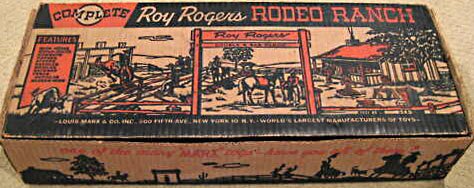 Name: Roy Rogers Rodeo Ranch Name: Roy Rogers Rodeo RanchNumber: 3985 and 3986 Year first issued: 1954 |
| Comments These were the last Roy Rogers sets with the 60mm figures and have only one character figure, a standing Roy Rogers either with hands on hips or with pistol drawn. In at least one #3986, the Roy Rogers figure was made in a rare chocolate color. Playset Magazine reports that #3985 was first released in 1954 and #3986 in 1956, but that Marx company documentation indicates their contents to be the same. However, in at least the later-produced #3986 sets, the ranch hands came in blue, yellow, and brown rather than the more traditional colors in #3985 of red brown, yellow, and cream. These same sets are reported to include 54mm horses rather than 60mm horses with separate saddles and reins, but I have no idea how the 60mm figure could stay on the 54mm horses! If you are lucky enough to find an unopened box, those with hand-stamped numbers should have the 60mm horses, while the ones with factory-printed numbers get 54mm horses. |
| Source(s) PFPC SE, PM 24, Horowitz |
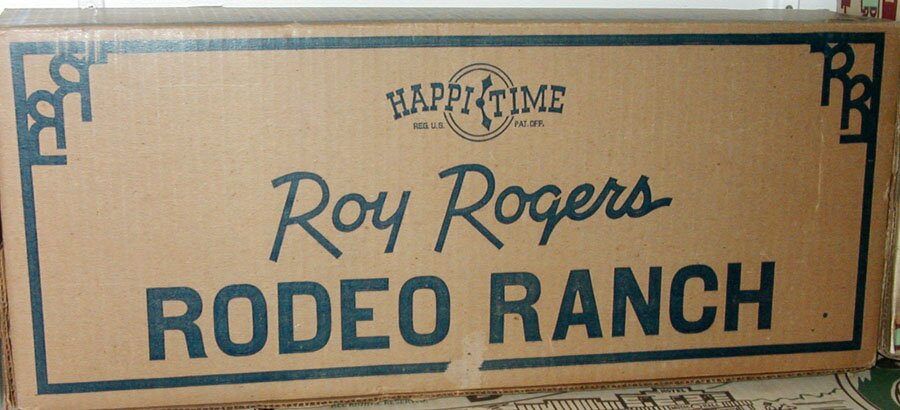 Name: Happi-Time Roy Rogers Rodeo Ranch Name: Happi-Time Roy Rogers Rodeo RanchNumber: 3992 Year first issued: 1955 |
| Comments The Happi-Time designation means that the set was sold by Sears Roebuck. |
| Source(s) PFPC SE, PM 24, Horowitz |
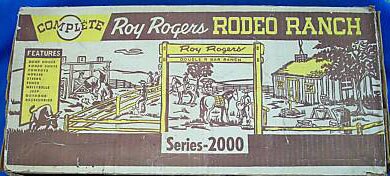 Name: Roy Rogers Rodeo Ranch Name: Roy Rogers Rodeo RanchNumber: 3996 Year first issued: 1957 |
| Comments |
| Source(s) PFPC SE, PM 25, Horowitz |
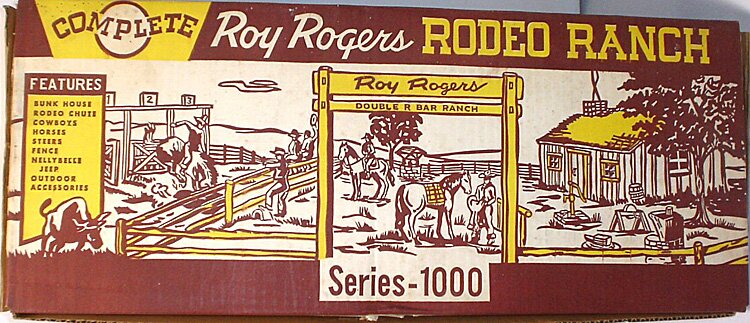 Name: Roy Rogers Rodeo Ranch Name: Roy Rogers Rodeo RanchNumber: 3988 Year first issued: 1957 |
| Comments |
| Source(s) PFPC SE, PM 25 |
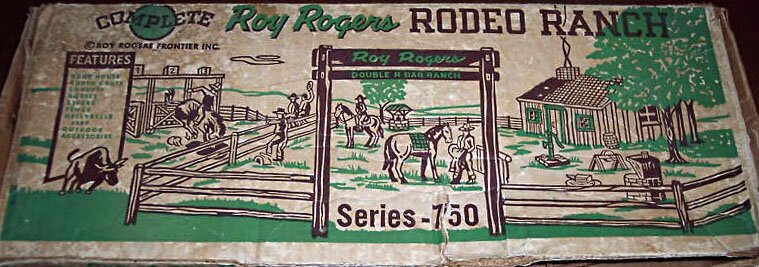 Name: Roy Rogers Rodeo Ranch Name: Roy Rogers Rodeo RanchNumber: 3987 Year first issued: 1958 |
| Comments |
| Source(s) PFPC SE, PM 25 |
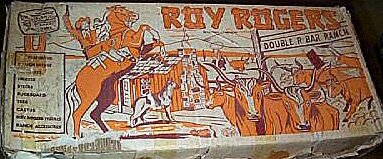 Name: Roy Rogers Double-R-Bar Ranch Name: Roy Rogers Double-R-Bar RanchNumber: 3989 Year first issued: 1959 |
| Comments |
| Source(s) PFPC SE, PM 25, Horowitz |
Number: 3982 Year first issued: 1962 |
| Comments |
| Source(s) PFPC SE, PM 25, Horowitz |
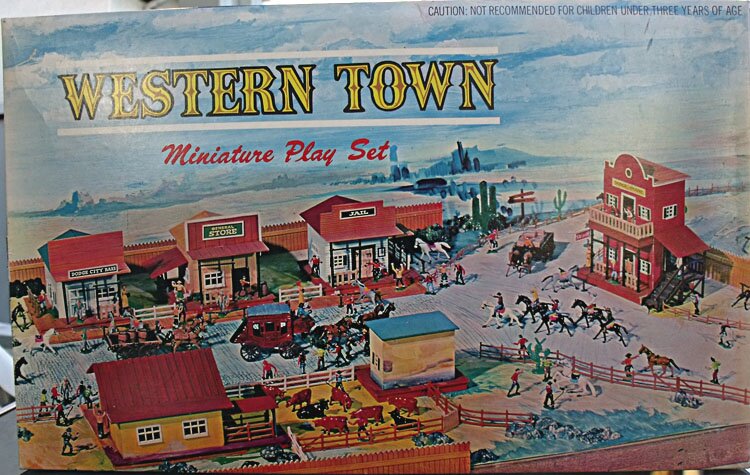 Name: Western Town Miniature Play Set Name: Western Town Miniature Play SetNumber: HK-8933 Year first issued: early 1960s, exact year unknown   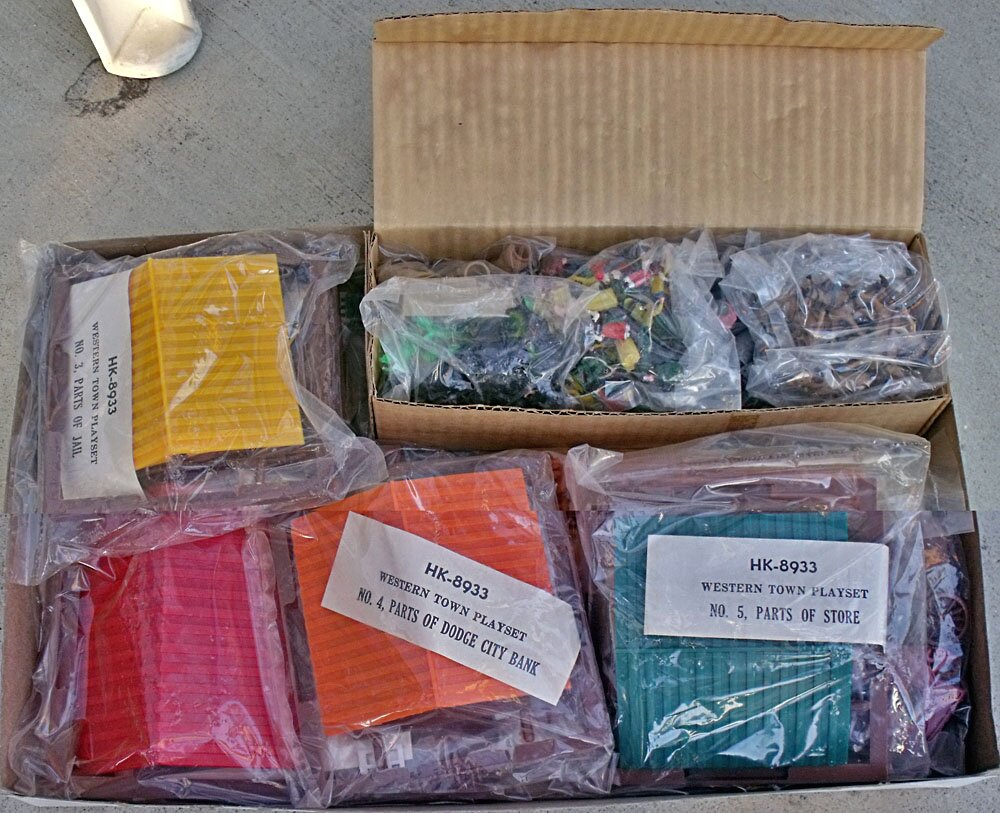 Comments I am lucky enough to own this set very nearly mint. The set I received had been opened, but every bag in the box was still sealed. The box has the six buildings shown on the box top, including the large Dodge House which is a combined saloon-hotel. The smaller buildings included a general store, bank, blacksmith, jail, and barber shop. Unlike the tin lithographed buildings in the larger scale sets, the buildings here are made of thick card stock and plastic. No traditional playset in 54mm or 60mm scale could offer so many buildings. I have seen more of the town sets for sale on Ebay than any other wild west miniature set. The two smaller photos above are the box sides. The photo at right is what the inside of the box looked like when it was first opened. The structures and terrain pieces are all in plastic bags "loose" in the box, while the figures and smaller accessories are in bags within a smaller box (opened in the photo). I do not generally provide information on specific playset contents, but I have never seen a contents list for this set and therefore will list exactly what I found in it: 1 large plastic bag with instructions and cardstock pieces for the six buildings 1 playset mat 1 bag of plastic pieces for blacksmith shop (labeled No. 1) 1 bag of plastic pieces for barber shop (No. 2) 1 bag of plastic pieces for jail (No. 3) 1 bag of plastic pieces for Dodge City Bank (No. 4) 1 bag of plastic pieces for store (No. 5) 1 bag of plastic pieces for Dodge House (No. 6) 1 bag of 10 pieces of yellow picket fencing 1 bag of 12 pieces of brown wooden rail fencing with a large number of tiny feet for the fence 1 bag with parts for a red stagecoach and two brown buckboards, including wagons, hitches, wheels, and metal axles 1 bag of animals (2 standing cows, 2 lying cows, 2 standing sheep, 2 lying sheep, 1 small standing dog, and 1 large standing dog) 1 bag of 8 tan wagon horses 1 bag of 8 horses with bases (2 brown horses with one foot up, 2 black horses with front two feet up, and 4 black horses with one foot up) 1 bag of 8 running horses without bases (4 white, 4 gray) 1 bag of 24 cowboys (6 each of fighting with hat, fighting with no hat, drawing pistol, pointing pistol forward, with whip, and with pistol and bag) 1 bag of 50 cowboys (5 each of hands up, woman with basket, outlaw pointing pistol with safe box, two guns drawn, walking with branding iron, with rope and harness (WOW pose), twirling rope (WOW pose), Dale Evans pose waving, Flint McCullough pose (slightly crouching with pistol drawn), and Seth Adams pose (walking with rifle and whip) 1 bag of 9 mounted cowboys and wagon riders (two mounted waving, two mounted with pistol, one mounted with rifle, two seated with whip, and two seated holding rifle) 1 bag of small accessories (1 hay wagon with connecting pin to hitch, 8 hitching posts, 1 dip well in two pieces, 4 barrels, 2 cacti similar to 54mm cacti, 2 cacti of a different type, 1 haystack with hole in top, 1 bottomless pumpkin that appears to fit on top of haystack, 1 anvil same as 54mm, 1 butter churn same as 54mm, and 3 tiny benches that are too small for the playset scale) Although the set was virtually mint, a few of the figures had broken pieces -- including all five of the cowboys with two guns drawn -- and the the hitches, axles and wheels were missing for one of the buckboards and the hay wagon (perhaps a bag was missing that contained these). The paint work on the figures was absolutely horrendous, though some figures were done slightly better than others. Of interest, there was some logic to the painting madness, as all figures in each pose were painted exactly the same colors. For example, all horse saddles are -- yuck -- light blue or pink! Overall, it is hard to imagine a youngster getting too excited about such terribly painted and fragile figures. I have heard that Glendale playset workers looked down their noses at the Hong Kong products, and based on this set, I can see why. I'm sure the quality of these sets did not help to stave off the eventual bankruptcy. By the way, I have no idea what the haystack-pumpkin thing is all about! |
| Source(s) PFPC 18, as well as the near-mint set I own, information from the box, and the set's instruction sheet. |
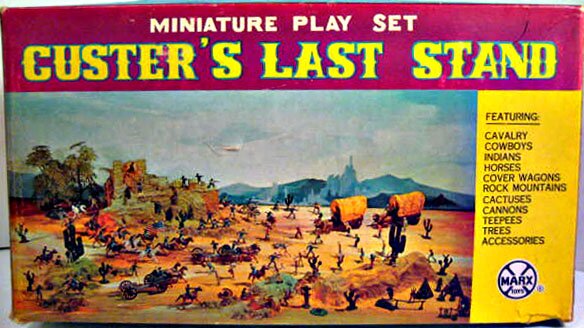 Name: Custer's Last Stand Miniature Play Set Name: Custer's Last Stand Miniature Play SetNumber: unknown Year first issued: unknown Photo courtesy of Ebay luby |
| Comments If you look closely at the box top above, you will see that Cavalry sharpshooters have taken up position on top of a steep mountain. This terrain piece is a part of the set, and PFPC refers to it as a "unique, pueblo-style mountain piece" that is the highlight of the set. As you can tell by the content listing on the front of the box, it had a ton of stuff in it. This set in good condition and pretty near complete sold for $545 in December 2009. |
| Source(s) PFPC 18; PM 2 pp. 20-21 and 3 p. 26. |
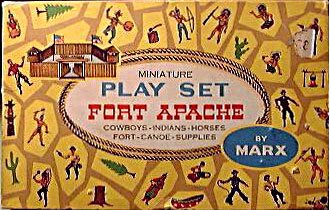 Name: Fort Apache Miniature Play Set Name: Fort Apache Miniature Play SetNumber: unknown Year first issued: unknown Cowboy version 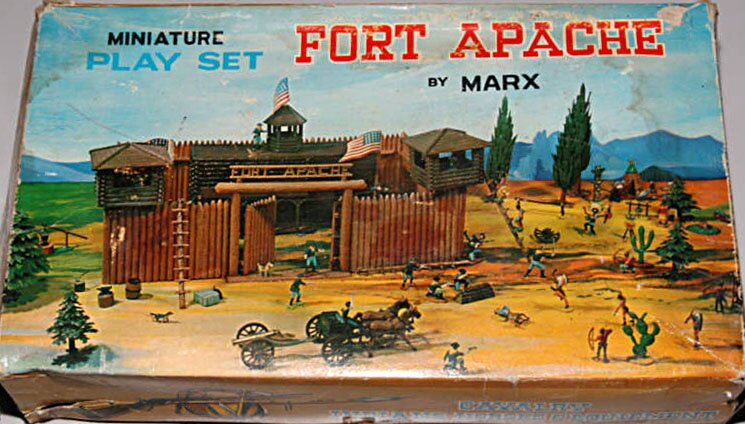 Cavalry version Photo courtesy of Mark, Ebay ID mark-nfa |
| Comments There were at least three and perhaps more versions of the miniature Fort Apache. The top box shown is the set with cowboys. Another version included U.S. Cavalry instead of cowboys, and I have seen photos of two boxes for the cavalrymen: one like the cowboy set above but with cavalrymen depicted on the box top and the other shown above. Many of the cowboys are small versions of Marx 54mm and 60mm figures -- including Seth Adams, Flint McCullough, and Dale Evans -- but there are also several new poses. The Cavalrymen are downsized versions of Marx 60mm Cavalry, and the Indians are a mixed bag with several poses from the Marx 3-inch Indian group and some that are not found in other scales. |
| Source(s) PFPC 18 |
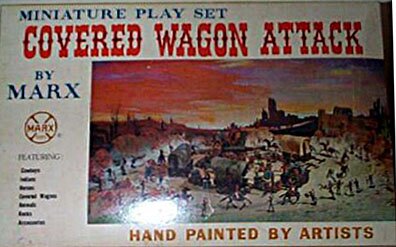 Name: Covered Wagon Attack Miniature Play Set Name: Covered Wagon Attack Miniature Play SetNumber: unknown Year first issued: unknown |
| Comments The incredible painting on the box top -- including one wagon on fire -- almost outdoes the playset inside the box. The set included five covered wagons and a large number of cowboys and Indians. I find it odd that Marx never made the larger scale version of this set. I guess the bigger Wagon Train sets came close. |
| Source(s) PFPC 18 |
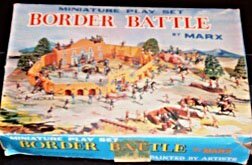 Name: Border Battle Play Set Name: Border Battle Play SetNumber: unknown Year first issued: unknown Photo courtesy of Jamie Zervos, Ebay Themid-nitepickle |
| Comments Titled Border Battle, this was actually an Alamo set. Almost all the figures and accessories are similar to the larger scale Alamo sets, but the "fort" has plastic walls and a plastic Alamo chapel. Mexican troops included both the Shako and round hat poses. See Page 6 of the Wild West Section for more information on this set. |
| Source(s) PFPC 18 |
| Recent Price Lines I have noticed | ||||
| $787 | November 2011 | Ebay | ||
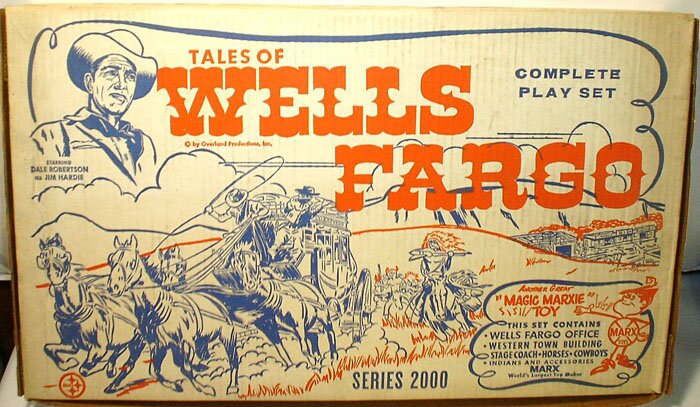 Name: Tales of Wells Fargo Name: Tales of Wells FargoNumber: 4262 Year first issued: 1959 |
| Comments |
| Source(s) PFPC SE and 26, Horowitz |
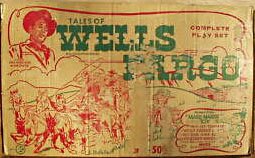 Name: Tales of Wells Fargo Name: Tales of Wells FargoNumber: 4263 Year first issued: 1959 |
| Comments |
| Source(s) PFPC SE and 26, PM 16 |
Number: 4264 Year first issued: 1959 |
| Comments |
| Source(s) PFPC SE and 26, Horowitz |
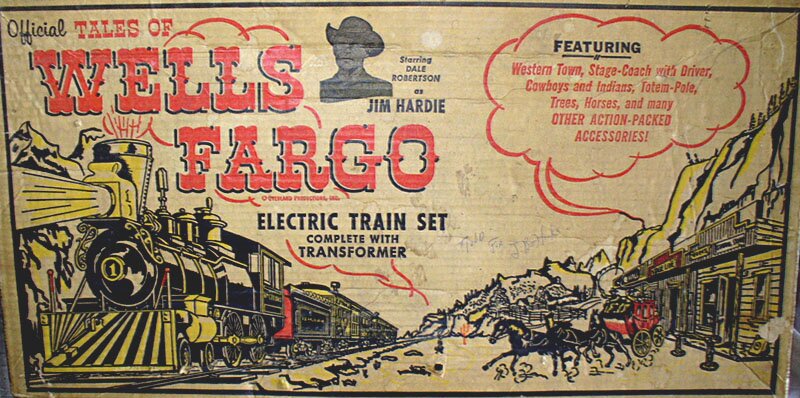 Name: Tales of Wells Fargo Electric Train Set Name: Tales of Wells Fargo Electric Train SetNumber: 54752 Year first issued: 1959 |
| Comments |
| Source(s) PFPC 26, PM 16 |
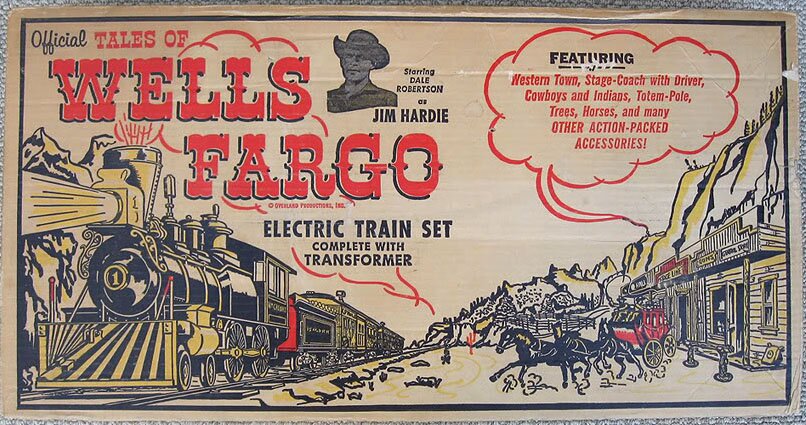 Name: Tales of Wells Fargo Electric Train Set Name: Tales of Wells Fargo Electric Train SetNumber: 54762 Year first issued: 1959 Photo courtesy of Corey DeMello, Ebay tagetfixation |
| Comments |
| Source(s) PFPC 26, PM 16 |
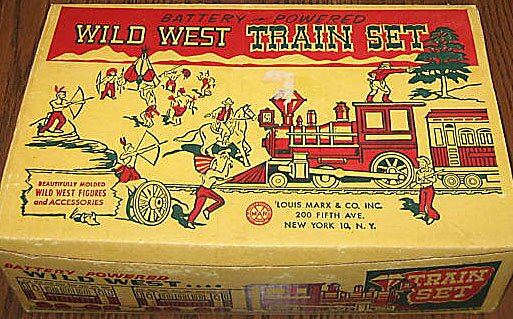 Name: Wild West Train Set Name: Wild West Train SetNumber: unknown Year first issued: unknown Photo courtesy of Dan Fowler, Ebay dan112055. |
| Comments Perhaps not technically a playset, this train set included 54mm cowboys and Indians and a group of outside accessories. As noted on the box, this was a battery-powered train set, not the usual Marx electric toy train. |
| Source(s) Photos and description from Ebay auction by Dan Fowler and verification from collector Mike Handley. |
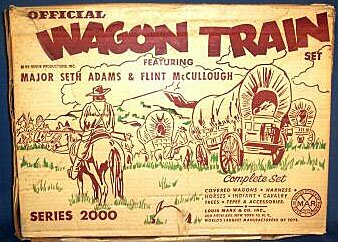 Name: Wagon Train Set Name: Wagon Train SetNumber: 4777 Year first issued: 1958 |
| Comments This set three 60mm covered wagons. |
| Source(s) PFPC SE and 30, PM 42 and 16, Horowitz |
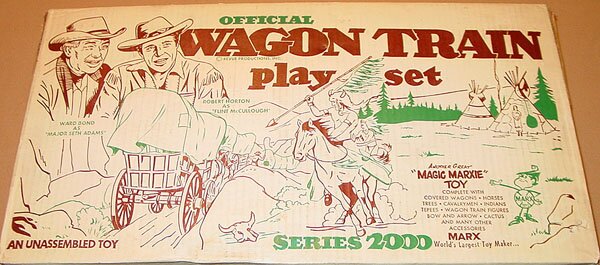 Name: Wagon Train Play Set Name: Wagon Train Play SetNumber: 4788 Year first issued: 1959 Photo courtesy of David Schafer. |
| Comments Early versions of this set had three 60mm covered wagons, but later versions switched to the new 54mm wagons. |
| Source(s) PFPC SE and 30, PM 42, Horowitz |
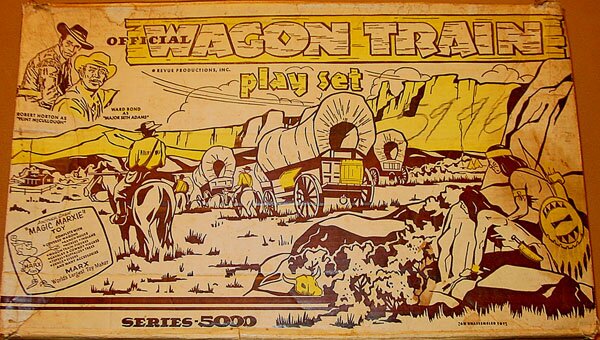 Name: Wagon Train Play Set Name: Wagon Train Play SetNumber: 4888 Year first issued: 1959 Photo courtesy of David Schafer. |
| Comments This set expanded to a whopping five 54mm wagons -- two red, two blue, and one yellow. |
| Source(s) PFPC SE and 30, PM 42, Horowitz |
| Recent Price Lines I Have Noticed | ||||
| $5,700 | March 2011 | Ebay | ||
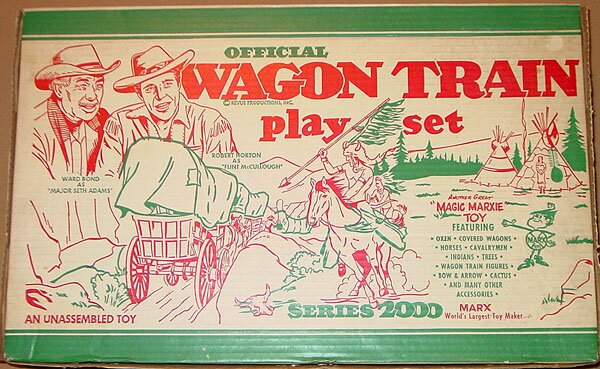 Name: Wagon Train Play Set Name: Wagon Train Play SetNumber: 4805 Year first issued: 1959 Photo provided by David Schafer. |
| Comments This final Wagon Train set had four 54mm wagons, with one of them pulled by oxen. |
| Source(s) PFPC 30, PM 42, Horowitz, Toy Soldiers and Collectibles Issue 3 |
| Recent Price Lines I have noticed | ||||
| $2,500 | January 2012 | Ebay | near complete | |
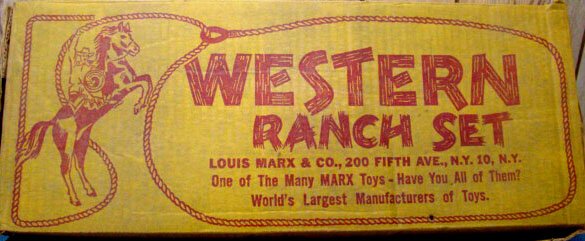 Name: Western Ranch Set Name: Western Ranch SetNumber: 39?? Year first issued: early 1950s |
| Comments |
| Source(s) PFPC SE |
 Name: Western Ranch Set Name: Western Ranch SetNumber: 3954 Year first issued: early 1950s |
| Comments |
| Source(s) PFPC SE |
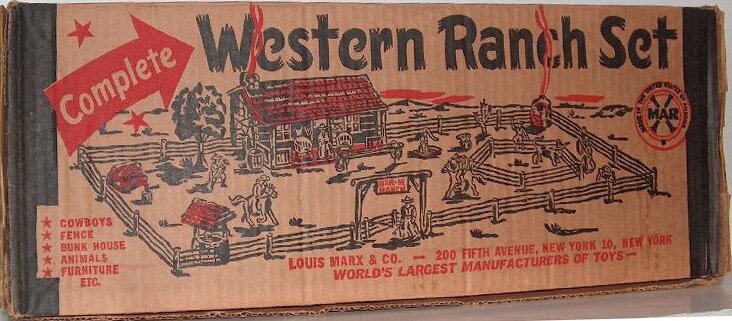 Name: Western Ranch Set Name: Western Ranch SetNumber: 39?? Year first issued: early 1950s |
| Comments |
| Source(s) PFPC SE |
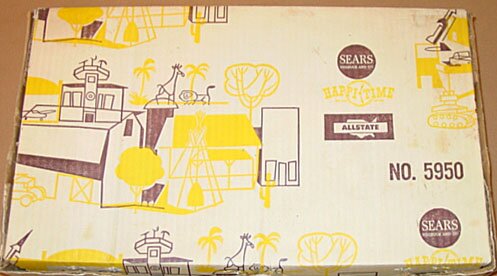 Name: Happi-Time Western Ranch Set Name: Happi-Time Western Ranch SetNumber: 5950 Year first issued: late 1950s Photo courtesy of David Schafer. |
| Comments This appears to be the last Western Ranch set issued, after Marx and Roy Rogers severed ties in the late 1950s. Based on David Schafer's photos, the set included a Roy Rogers type gate with no lettering on the gate. The Happi-Time designation means that the set was sold by Sears Roebuck. |
| Source(s) PFPC SE |
 Name: Roy Rogers Western Town Name: Roy Rogers Western TownNumber: 4258 Year first issued: 1952 |
| Comments This set includes the 60mm town front with a hotel. |
| Source(s) PFPC SE and 40, PM 24, Horowitz |
 Name: Western Town Name: Western TownNumber: 4230 Year first issued: 1952 |
| Comments This set includes the 60mm town front with a hotel. |
| Source(s) PFPC SE and 40 |
 Name: Western Town Name: Western TownNumber: 4229 Year first issued: 1952 |
| Comments This set includes the 60mm town front with a jail. |
| Source(s) PFPC SE and 40 |
Number: 4257 Year first issued: 1952 |
| Comments |
| Source(s) PFPC SE and 40, PM 24, Horowitz |
Number: 4256 Year first issued: 1954 |
| Comments This set includes the 60mm town front with a hotel. |
| Source(s) PFPC SE and 40, Horowitz |
 Name: Silver City Western Town Name: Silver City Western TownNumber: 4219 Year first issued: 1955 |
| Comments This set includes the 60mm town front with a hotel. |
| Source(s) PFPC SE and 40, Horowitz |
 Name: Silver City Frontier Town Name: Silver City Frontier TownNumber: 4220 Year first issued: 1955 |
| Comments This set includes the 60mm town front with a hotel. |
| Source(s) PFPC SE and 40, Horowitz |
 Name: Silver City Western Frontier Town Set Name: Silver City Western Frontier Town SetNumber: 4268 Year first issued: 1956 |
| Comments This was the only playset that included both 60mm townfronts, one with the hotel and the other with the jail. It also was the only one that included painted figures. |
| Source(s) PFPC SE and 40, Horowitz |
Number: 4228 Year first issued: 1957 |
| Comments This first Wyatt Earp town playset was sold exclusively by Montgomery Ward. They also sold a very similar version under the same number in 1958. They the 60mm town front with hotel, a stagecoach, two sets of 54mm cowboys, and a set of 54mm Indians. |
| Source(s) PFPC SE and 40, PM 16 and 66, Horowitz, Toy Soldiers and Collectibles magazine Issue 2 |
 Name: Roy Rogers Western Town Name: Roy Rogers Western TownNumber: 4259 Year first issued: 1957 |
| Comments This set included the 60mm town front with a jail, as well as the Bar-M-Ranch cabin. According to PM 24, the set included 54mm cowboys, the Nellybelle jeep, and a stagecoach. |
| Source(s) PFPC SE and 40, PM 25 |
Number: 4227 Year first issued: 1958 |
| Comments This set included the 60mm town front with a hotel. |
| Source(s) PFPC SE and 40, PM 25 |
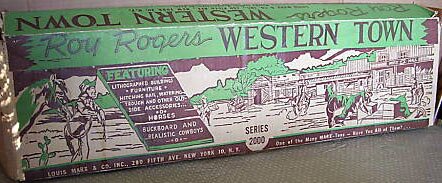 Name: Roy Rogers Western Town Name: Roy Rogers Western TownNumber: 4216 Year first issued: 1958 |
| Comments This set included the 60mm town front with a jail. |
| Source(s) PFPC SE and 40, PM 25, Horowitz |
 Name: Roy Rogers Western Town Name: Roy Rogers Western TownNumber: 4255 Year first issued: 1958 |
| Comments |
| Source(s) PFPC SE and 40, PM 25, Horowitz |
Number: 4226 Year first issued: 1958 |
| Comments This set included the 60mm town front with a hotel. It was featured in the Spiegel's catalog for the 1958 holiday season and included a blue buckboard with the "hoop" hitch instead of a stagecoach, which was included in Wyatt Earp sets sold by Wards. As the 1958 Wards set (see next set), it included cowboy and Indian weapon sprues. |
| Source(s) PFPC SE and 40, PM 66, Horowitz, Toy Soldiers and Collectibles magazine Issue 2 |
 Name: Hugh O'Brian Wyatt Earp Dodge City Western Town Name: Hugh O'Brian Wyatt Earp Dodge City Western TownNumber: 4228 Year first issued: 1958 |
| Comments The second of two Wyatt Earp set sold by Wards, this one was almost identical to the first one sold in 1957. This one included cowboy and Indian weapon sprues.. |
| Source(s) PFPC SE and 40, PM 16 and 66, Horowitz, Toy Soldiers and Collectibles magazine Issue 2 |
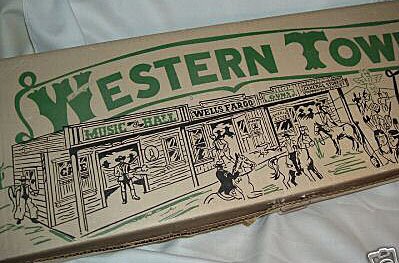 Name: Western Town Name: Western TownNumber: 4252 (?) Year first issued: 1959 |
| Comments The set included the 60mm town front with a hotel. |
| Source(s) PFPC SE |
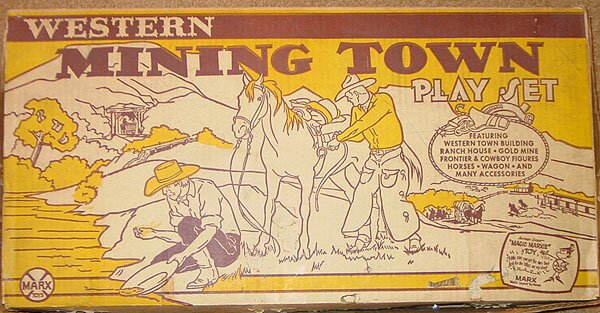 Name: Western Mining Town Play Set Name: Western Mining Town Play SetNumber: 4265 Year first issued: 1960 |
| Comments The set included the 60mm town front with a hotel. |
| Source(s) PFPC SE and 8, Horowitz |
Number: 4266 Year first issued: 1960 |
| Comments The set included the 60mm town front with a hotel. |
| Source(s) PFPC SE and 8, Horowitz |
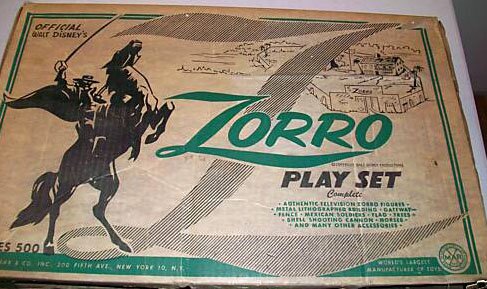 Name: Walt Disney's Zorro Play Set Name: Walt Disney's Zorro Play SetNumber: 3753 Year first issued: 1958 |
| Comments This "Green Box" set was the smallest one, labeled Series 500. However, it included all the necessary Zorro items: the six character figures, 32 Sombrero Hat Mexican soldiers, the Mexican fort and Hacienda, and Zorro's cave. |
| Source(s) PFPC SE and 28, PM 8 |
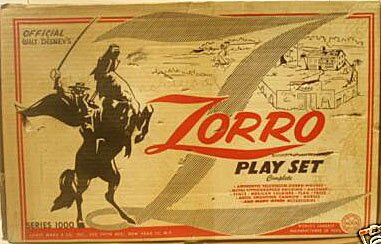 Name: Walt Disney's Zorro Play Set Name: Walt Disney's Zorro Play SetNumber: 3754 Year first issued: 1958 |
| Comments The "Red Box" set was actually two sets, one Series 750 and the other Series 1000. The higher the series number, the more pieces in the box. These sets, for example, included not only the new Sombrero Hat Mexican soldiers, but also the old Alamo Shako Hat soldiers. Collectors have found that the contents of these sets are not always the same and, in some cases, the Zorro cave has been missing. Playset Magazine notes that Sombrero Hat soldiers in "a highly desireable lavender color" come from the Series 750 set. |
| Source(s) PFPC SE and 28, PM 8 |
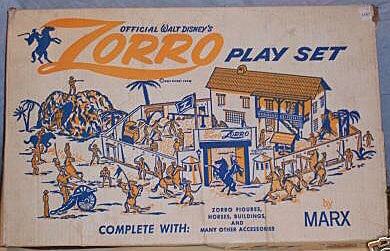 Name: Walt Disney's Zorro Play Set Name: Walt Disney's Zorro Play SetNumber: 3758 Year first issued: 1965 |
| Comments Known as the "Gold Box" set, this playset was released when the Zorro television shows were re-run in the 1965-66 television season. Playset Magazine reports that contents of the set were not always identical, but the set included the Zorro cave with a new paint scheme, character figures are waxy yellow or white, and Mexican soldiers were semi-waxy. |
| Source(s) PFPC SE and 28, PM 8, Horowitz |
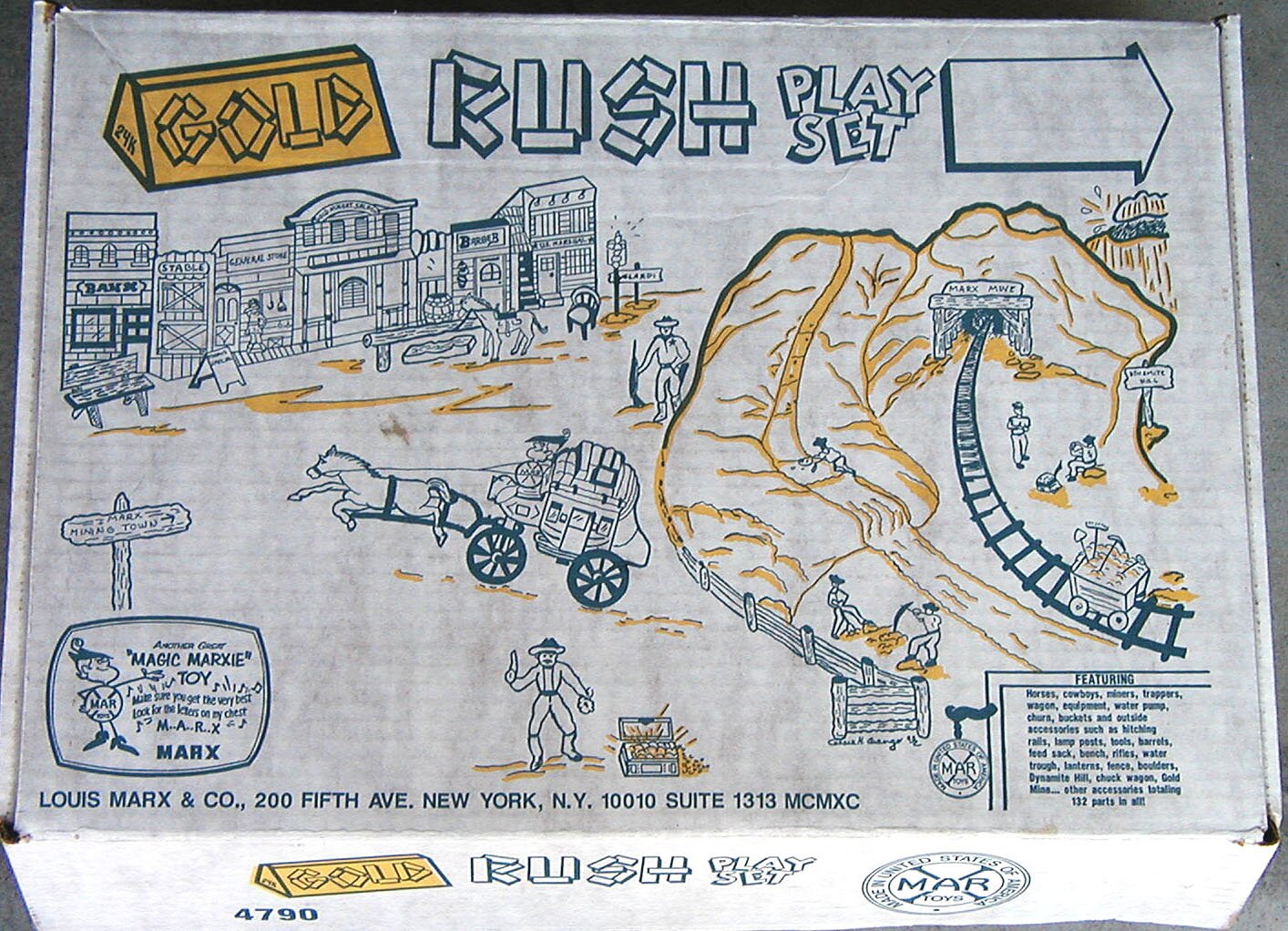 |
| 1990 - Gold Rush Play Set Labeled Louis Marx & Co. and even provided a play set number (#4790), it was still a re-issue 10 years after the company ceased to exist. The set includes a plastic MPC town front and a glaringly red stagecoach, but overall was a nice play set. |
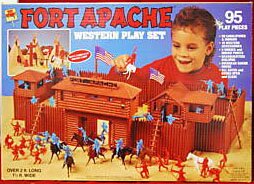 |
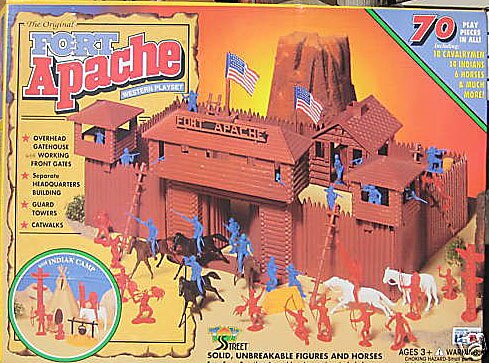 |
| early 1990s - Fort Apache Play Sets These are two of several re-issue Marx playsets produced by Toy Street. They were sold primarily at Toys-R-Us from about 1989 to 1992. Photos courtesy of Bill Nevins, Ebay nevinsrip. |
|
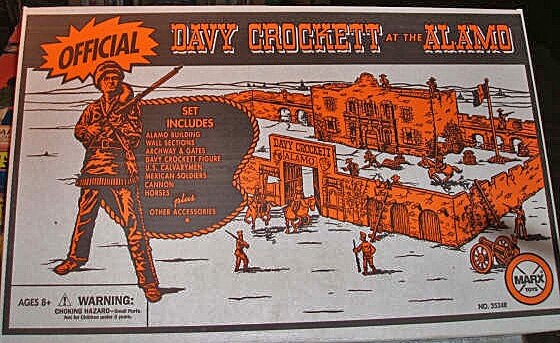 |
| 1995 - Davy Crockett at the Alamo Another re-issue bearing the Marx logo for the Alamo battle's 160th anniversary. Notice the modern choking hazard warning in the lower left corner, a clue that it is not an original. (Photo courtesy of Bob Szukala) |
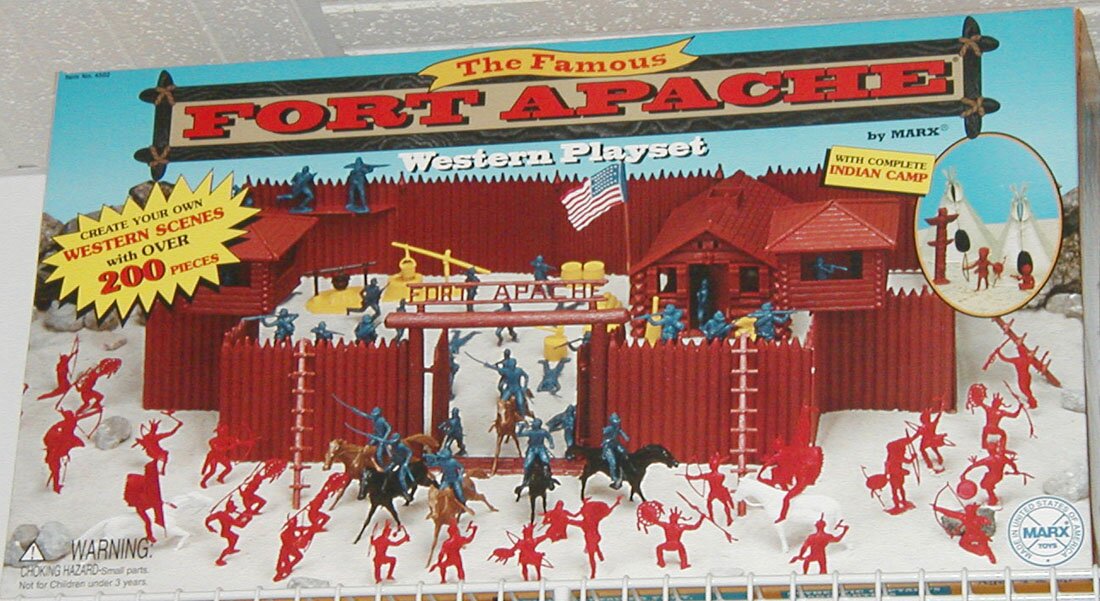 |
| Fort Apache Western Playset issued in the 1990s by Kay Bee Toys, which was founded by Marx family members. The designation "Famous" at the top of the box is a heavy hint that this set is not authentic Marx. Note also the odd cabin and the ugly yellow accessories. |
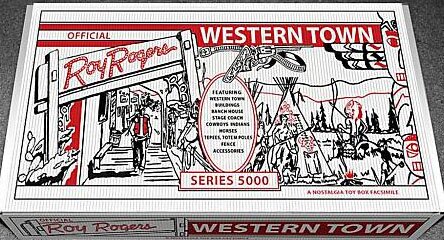 |
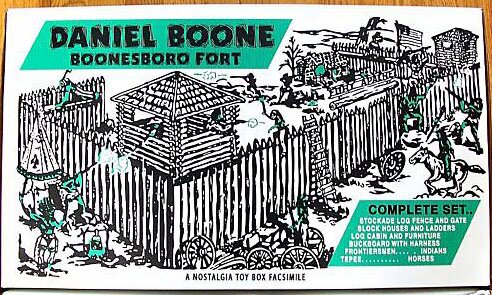 |
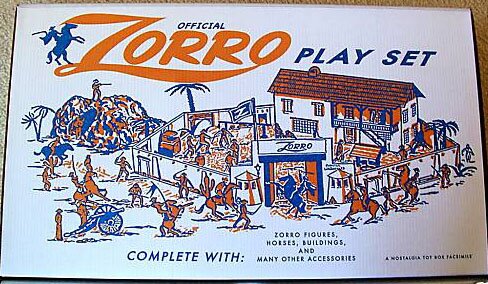 |
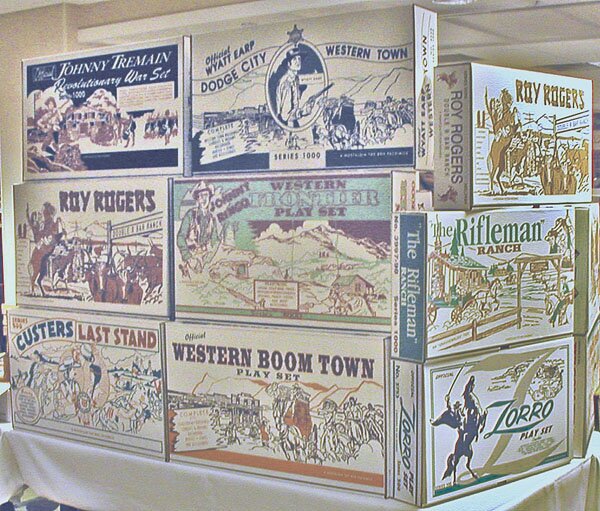 |
| Nostalgia Toy Box display at 2009 OTSN |